User Guide
Welcome To TrackO’s User Guide!
Tired of configuring multiple ugly spreadsheets on Microsoft Excel or Google Sheets to track your business?
Or are you perhaps finding it increasingly difficult to manage pen and paper records as your business grows?
Then TrackO might just be the solution for you! With TrackO, you no longer need to worry about inconsistencies when you update your data across multiple spreadsheets or paper records. No more complicated formulas to link data between spreadsheets. No need for inefficient paper records that pile up in your storeroom.
In this user guide, you will find step-by-step instructions on how to install TrackO, as well as learn about the neat functionalities of TrackO that will make your life easier!
If you are looking to help develop this project, take a look at our Developer Guide too.
Table of Contents
- Introduction
- Layout
- Using this guide
- Command guide
- Symbols and Syntax
- Quick start
- Tutorial
- Features
- FAQ
- Command Summary
- Glossary
Introduction
TrackO is a desktop application built for small home-based business owners (just like you!) to manage their orders and inventory items. It is an integrated solution that merges the process of tracking orders and inventory in one place, optimized for use via a Command Line Interface (CLI), while still having the benefits of a Graphical User Interface (GUI).
If you love to type, TrackO can get your order and inventory management tasks done faster than the traditional solution of pen and paper, and even popular GUI applications such as spreadsheets (e.g. Microsoft Excel, Google Sheets, etc.).
Even if you are not that comfortable with typing, fret not! TrackO is built with you in mind. The functionalities are beginner-friendly and extremely easy to pick up.
As a broad overview, TrackO provides users with the ability to:
- View and manage inventory data
- View and manage order data
- Ensure consistency between inventory and order data (e.g. automatically updating in-stock quantities on marking orders as paid/delivered)
Currently, TrackO only supports tracking inventory items that are countable by units (e.g. 1 apple, 2 cookies, etc.). Our development team will introduce more powerful inventory tracking functionalities (e.g. by weight, by litres, etc.) in future enhancements of the product (stay tuned!).
Interested? Jump straight to our Quick Start section to get started now!
Using this guide
Feeling overwhelmed already? Fret not because this user guide is meant to help you integrate this application seamlessly into your business operations.
As a first time user, we understand that it might be daunting to start up the application without sufficient instructions. We have prepared a Quick Start section in this guide to equip you with the knowledge to start up TrackO for your business.
The Layout will also help you understand the different sections of TrackO’s GUI and their functionalities.
After familiarising yourself with the GUI, head over to the Tutorial section where you can learn some of the application’s commands by playing with our sample data.
To know more about the general formats of the commands in the application, you can proceed to the Command Guide. This will get you ready for the in-depth explanation of each command’s format and use cases which can be found in the Features section. The features are organised into the core component of the application that they belong to, order management and inventory management. You can also find general features that do not belong to those categories.
Lastly, we have included a handy Command Summary section for when you’re proficient at using TrackO and just want to take a quick look at any commands you need!
p.s. Not too sure about some technical terms in this guide? Check out our glossary to get a better understand all the technical jargon!
Symbols and Syntax
As you read through this document, you might come across some symbols and highlighted words, as described in the table below:
| Symbol/Syntax | Meaning |
|---|---|
|
|
Information that you need to pay attention to. |
|
|
Information that you may find helpful. |
|
|
Information that you need to know before executing a command |
Highlighted text block |
Commands or parameters that you can enter into our application, or text that is directly displayed in our application |
| Hyperlinked text in blue | When it is pressed, it should lead you to another section in the document or to an external link. |
Quick start
-
Ensure you have Java
11or above installed in your Computer. To do so, refer to this FAQ here. -
Download the latest
TrackO.jarfrom here. -
Copy the file to the folder you want to use as the home folder for your TrackO.

 Tip:
Any folder can be a home folder for your TrackO. However, it is recommended that you use an empty folder as
your home folder, as the file containing your data will also be stored in this folder. In this case, the home
folder is an empty folder called
Tip:
Any folder can be a home folder for your TrackO. However, it is recommended that you use an empty folder as
your home folder, as the file containing your data will also be stored in this folder. In this case, the home
folder is an empty folder called TrackOlocated in theDesktop. -
Double-click the file to start the app. The GUI similar to the one below should appear in a few seconds. The application will already contain some sample data.

-
Head over to the tutorial section for a small walkthrough of some of TrackO’s commands and use cases.
-
If you’d like to skip the tutorial, head over to the features section for some of the more technical and in-depth explanation of each command’s format a use case.
clear command to remove
the application’s sample data.
Layout
The image below describes TrackO’s layout:

Tutorial
To get you started, here are some simple commands you can try out on our sample data before getting to know more of TrackO’s functionalities!
-
We start off by getting to know how to manage your inventory!
-
Adding an item:
addi- Suppose you have
350units of the itemTeddy bear keychaincurrently in your physical inventory. Each unit costs$0.89to produce, and you will be selling them at$3.50each. - You can add this as an inventory item to TrackO by entering the following command into the command box:
addi i/Teddy bear keychains q/350 d/Great for kids! t/New sp/3.50 cp/0.89 -
This command also adds a short description,
Great for kids!to the item and tags it asNew.You should see this item appear in TrackO at index
5as shown below: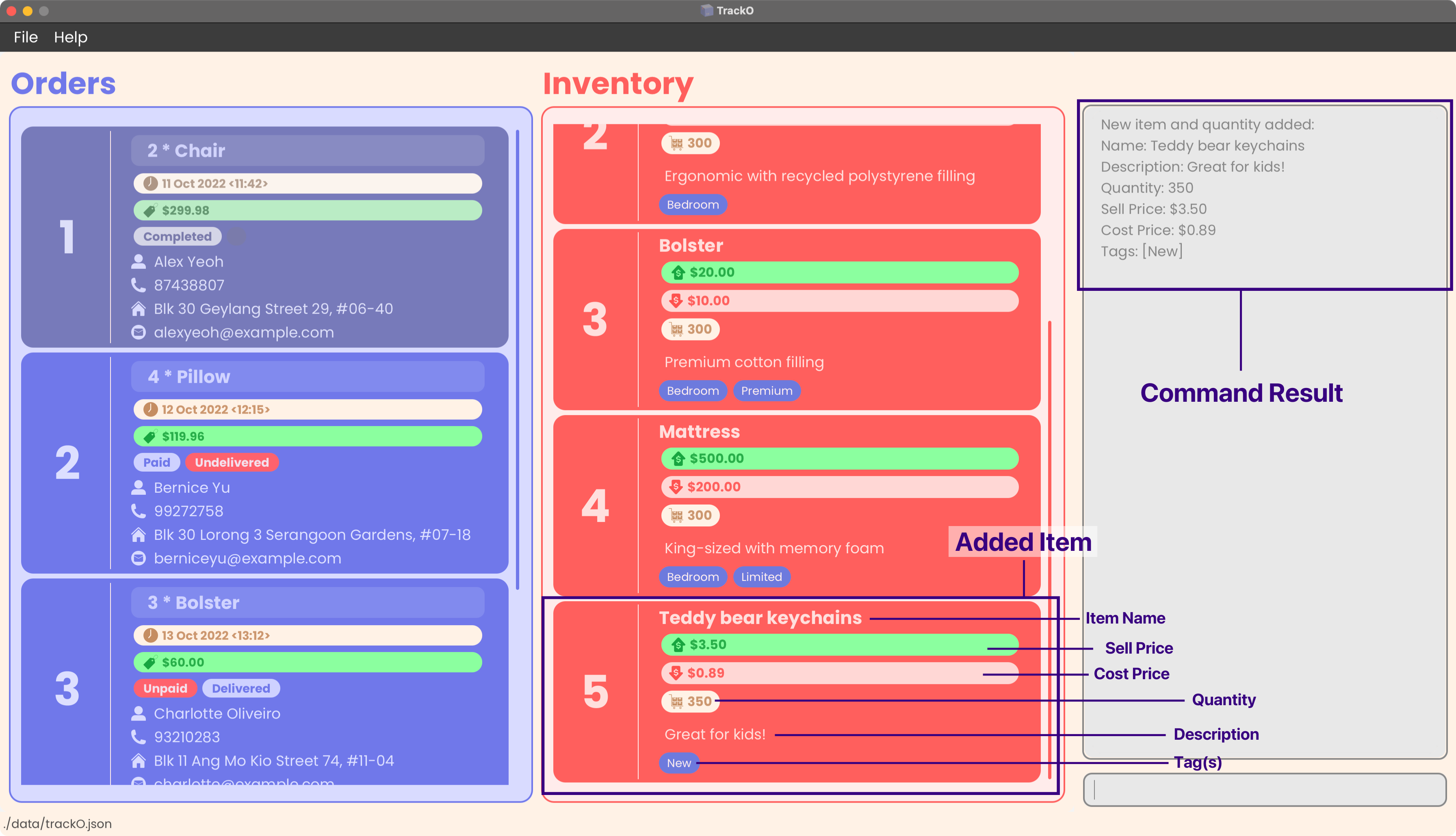
- Suppose you have
-
Adding an item:
-
Next, we move on to managing your orders!
-
Adding an order:
addo- Suppose a customer by the name
Jonathan Cheewants his order delivered to43 Clementi Road, 639433. He is contactable by the emailJonChee@gmail.comand at the phone number96785944. He has also ordered 1 unit ofTeddy bear keychain. - Firstly, initiate the
addocommand with the customer details by entering the following command into the command box:
addo n/Jonathan Chee p/96785944 e/JonChee@gmail.com a/43 Clementi Road, 639433 - Next, to add the items ordered by the customer, enter the following command into the command box:
i/teddy bear keychains q/1 -
Finally, enter
doneto finish adding the order to TrackO!You should see this order appear in TrackO at index
5as shown below: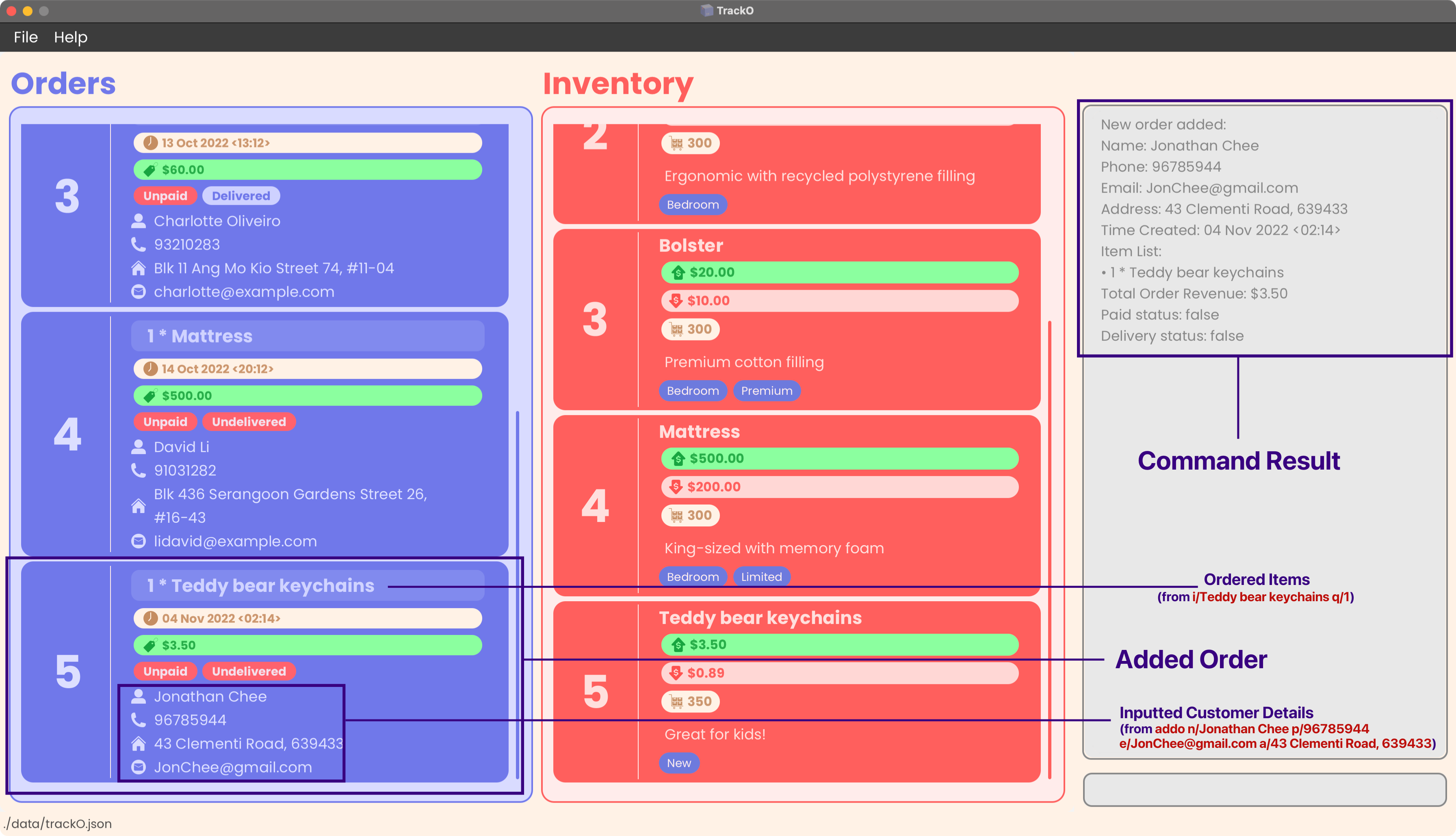
 Note:
If an item is not in your inventory, TrackO does not allow you to add that item to an order!
Note:
If an item is not in your inventory, TrackO does not allow you to add that item to an order!
- Suppose a customer by the name
-
Finding order(s):
findo- Our application allows you to search for orders by different fields (e.g. payment status, delivery status, customer details).
-
To find orders to be delivered to
Clementiwhich have not been paid for, enter the following command to the command box:findo -P a/ClementiYou should see these orders appear in the order list, as shown below:
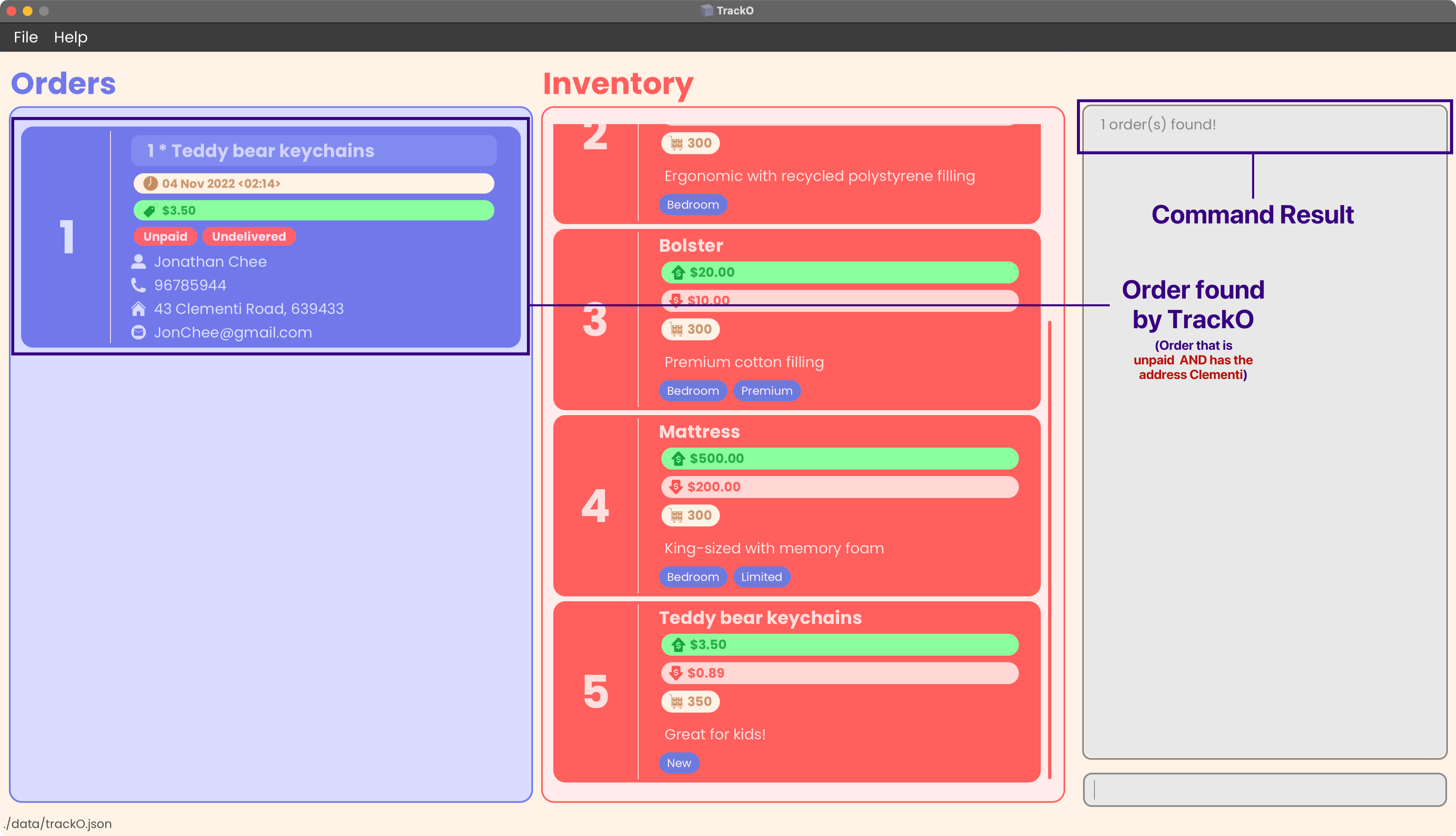
-
Listing order(s):
listo-
To view all your orders again, enter
listo.You should see these orders appear in the order list, as shown below:
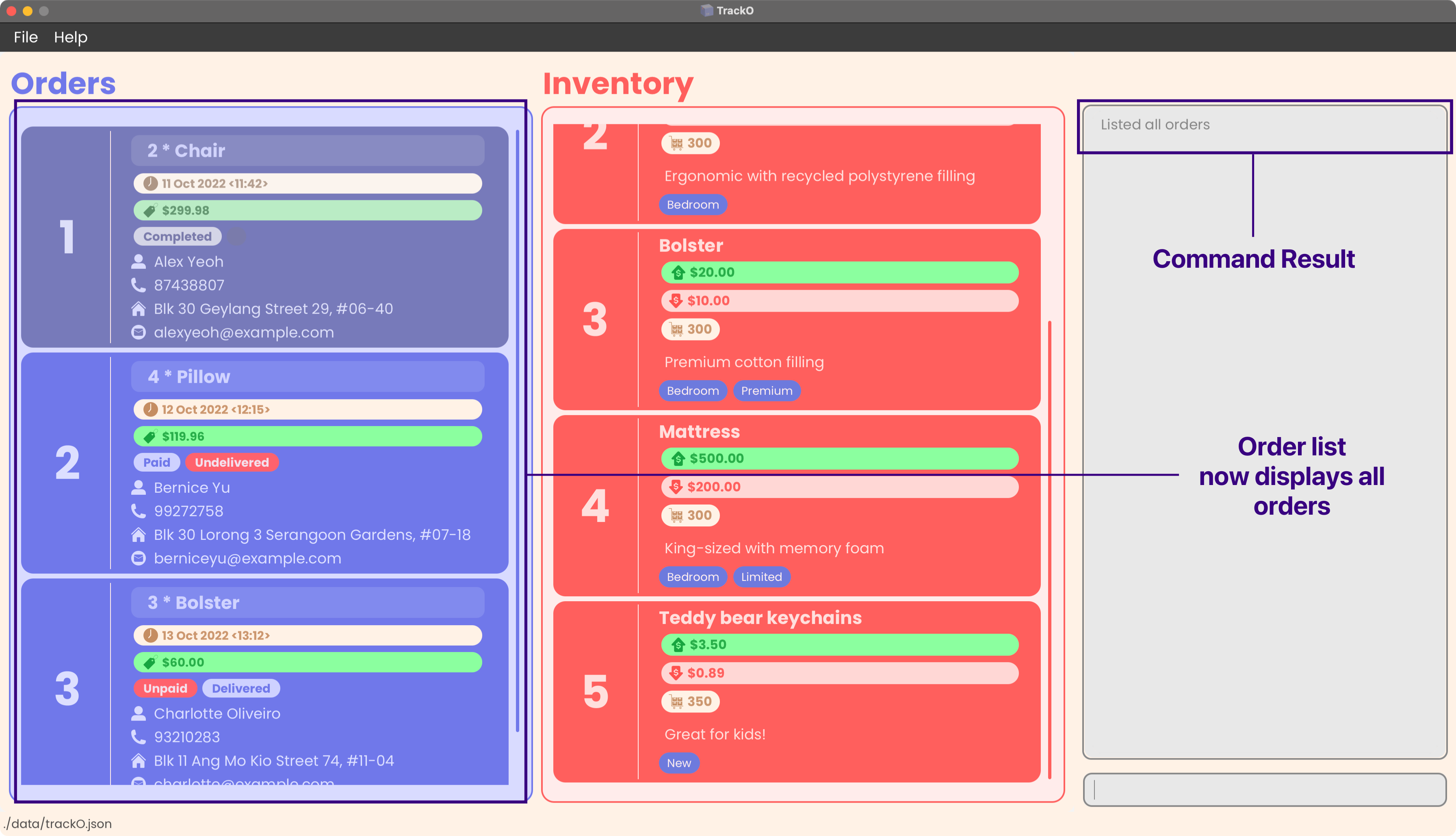
-
-
Adding an order:
Now that you’re done trying out some commands, you can enter exit to leave the application. We hope that this short tutorial was helpful!
To check out more commands, you can head over to our Features section.
Command guide
This section of the user guide helps to break down the formatting used for commands in this user guide.
-
Words in
UPPER_CASEare the parameters to be supplied by the user.
e.g. inaddo n/NAME,NAMEis a parameter which can be used asaddo n/John Doe .... -
Parameters in square brackets
[]are optional.
e.g. infindo KEYWORD [MORE_KEYWORDS], only the firstKEYWORDis compulsory. The rest are optional. -
Parameters can be in any order.
e.g. if the command specifiesi/ITEM_NAME q/QUANTITY,q/QUANTITY i/ITEM_NAMEis also acceptable. -
All command keywords (e.g.
addo,marko,editi, etc.), prefixes (e.g.p/,i/, etc.) and flags (e.g.-p,-D, etc.) are case-sensitive, unless stated otherwise.
e.g.addois a valid command keyword, butaddOis invalid. -
If a parameter is expected only once in the command, but you specified it multiple times, only the last occurrence of the parameter will be taken.
e.g. if you specifyp/12341234 p/56785678, onlyp/56785678will be taken. -
If you use parameters for commands that do not take in parameters (such as
listi,listo,clearandexit), these parameters will be ignored.
e.g. if the command specifieslisti 123, it will be interpreted aslisti.
Features
This section contains information on each command’s format and its use cases.
Inventory management
The commands included in this section are related to inventory management.
As of v1.4, there are 5 commands.
Adding an inventory item: addi
Adds an item to the list of tracked inventory.
Format: addi n/ITEM_NAME q/QUANTITY d/DESCRIPTION sp/SELL_PRICE cp/COST_PRICE [t/TAG]…
-
SELL_PRICEis the amount that is received as revenue per unit of item sold -
COST_PRICEis the amount that it costs to produce per unit of the item -
SELL_PRICEandCOST_PRICEshould be given as a number rounded to the nearest cent - TrackO allows items to have a larger
COST_PRICEthanSELL_PRICE, where items can be sold at a loss
![]() Notes on tags:
Notes on tags:
- An inventory item can have 0 or more tags.
- Tags should only consist of 1 word.
- Tags cannot have more than 30 characters.
- Tags should be alphanumeric.
Example(s):
-
When you enter
addi i/Keychain q/20 d/Silicone keychain with a metal buckle sp/3.50 cp/1 t/Souvenirto our sample data, TrackO will add20 unitsofKeychainto your inventory list, with the cost price of$1and selling price$3.50. TheItemhas the descriptionSilicone keychain with a metal buckleand tagSouvenir.
The following result will be displayed in the application: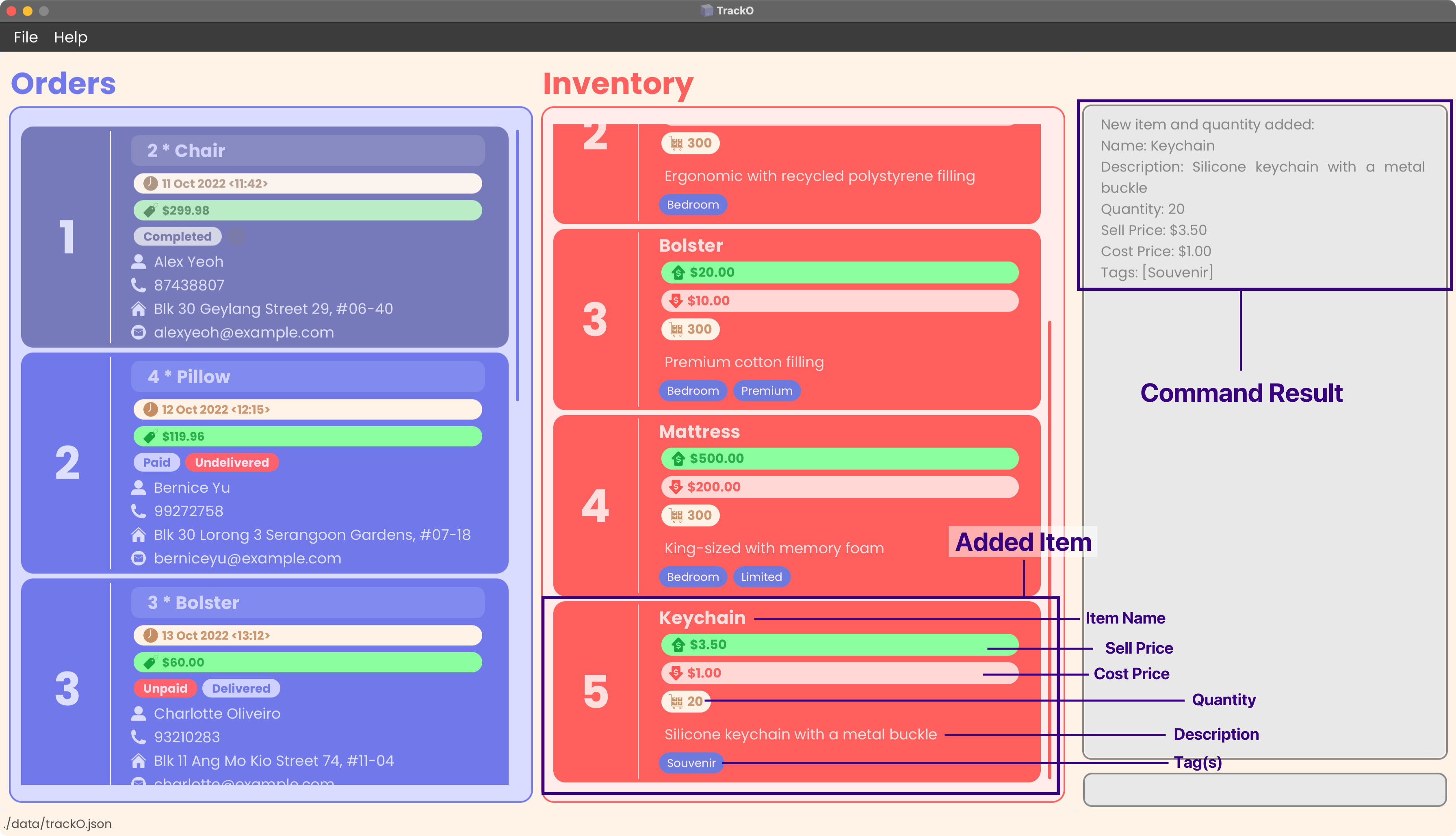
Listing all inventory items: listi
Lists all the existing items in the store’s inventory.
Format: listi
Example(s):
-
When you enter
listito our sample data, TrackO will list all the existing inventory items in yourInventory List. Executing it on our sample data will display the following result: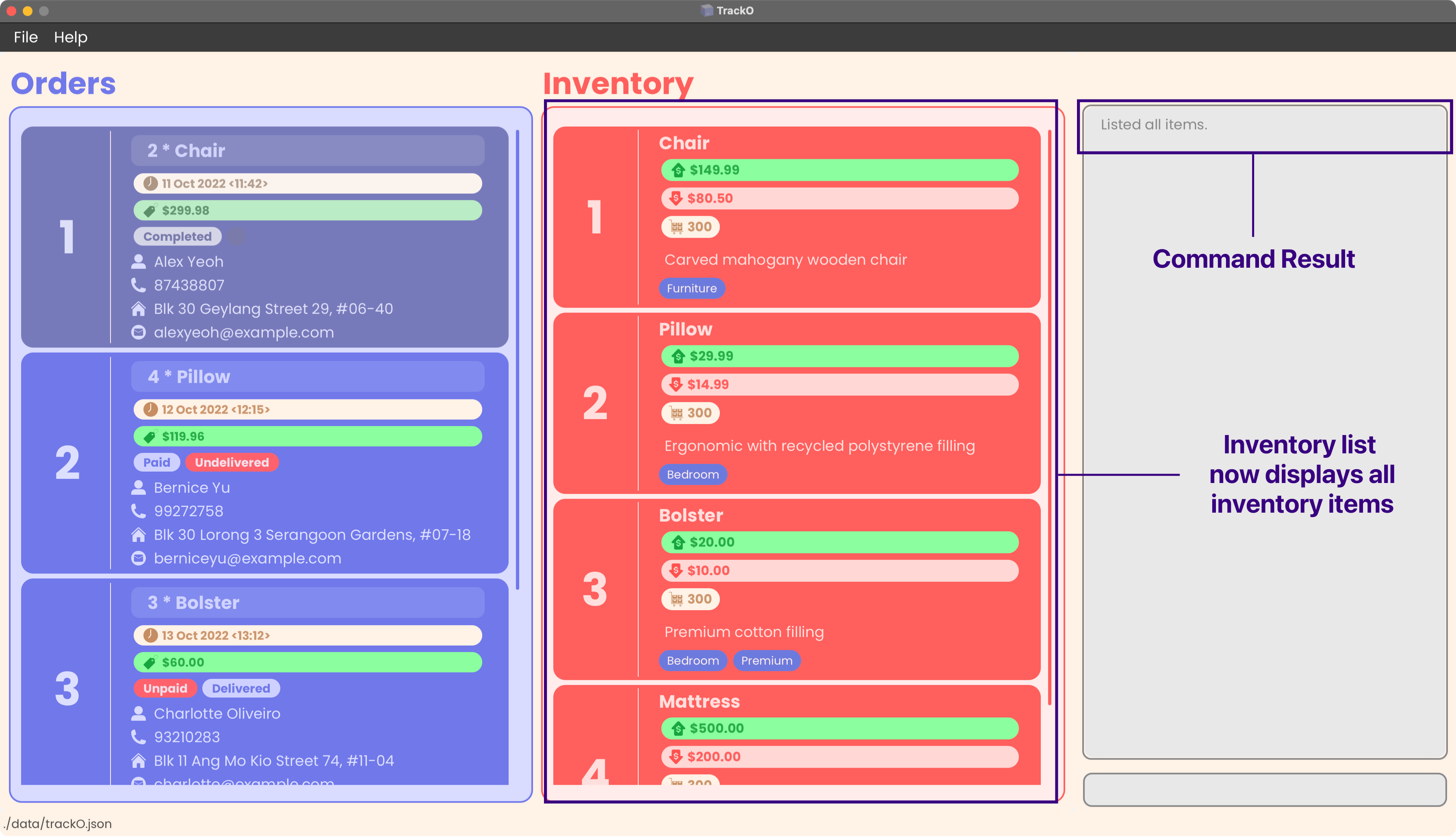
Finding an inventory item: findi
Finds an inventory item whose name fits any of the given keywords.
Format: findi KEYWORD [MORE_KEYWORDS]
- The search is case-insensitive. e.g.
keychainwill matchKeychain - The order of the keywords does not matter. e.g.
pants longwill matchlong pants - Only the name of the item is searched.
- Only full words will be matched. e.g.
keywill not matchKeychain - Items matching at least one keyword will be returned.
e.g.
shirtwill returndress shirt,collared shirt
Example(s):
-
When you enter
findi mattressto our sample data, TrackO will find items that contain the wordmattressin their item name and display the following result: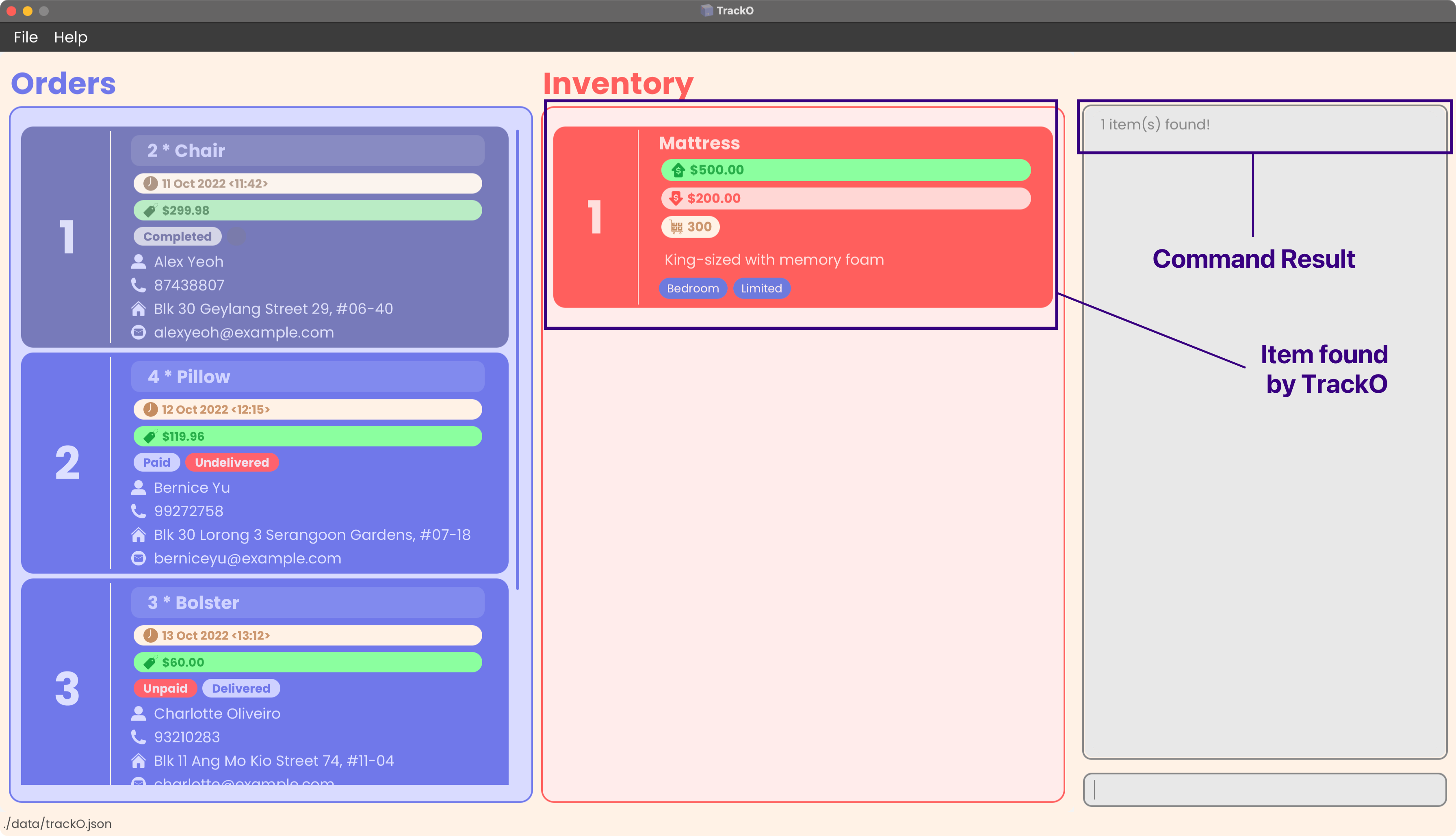
-
When you enter
findi mattress chairto our sample data, TrackO will find items that contain the wordmattressorchairin their item name, and display the following result:
Deleting an inventory item: deletei
Deletes the specified item from the list of tracked inventory.
Format: deletei INDEX
- Deletes the item at the specified
INDEX. -
INDEXrefers to the index number shown in the displayed inventory list. -
INDEXmust be a positive integer 1, 2, 3, …
Example(s):
-
When you enter
deletei 1to our sample data, TrackO deletes the first item,Chairfrom the inventory list. Notice how the order involvingChairis completed, which allows theChairto be deleted: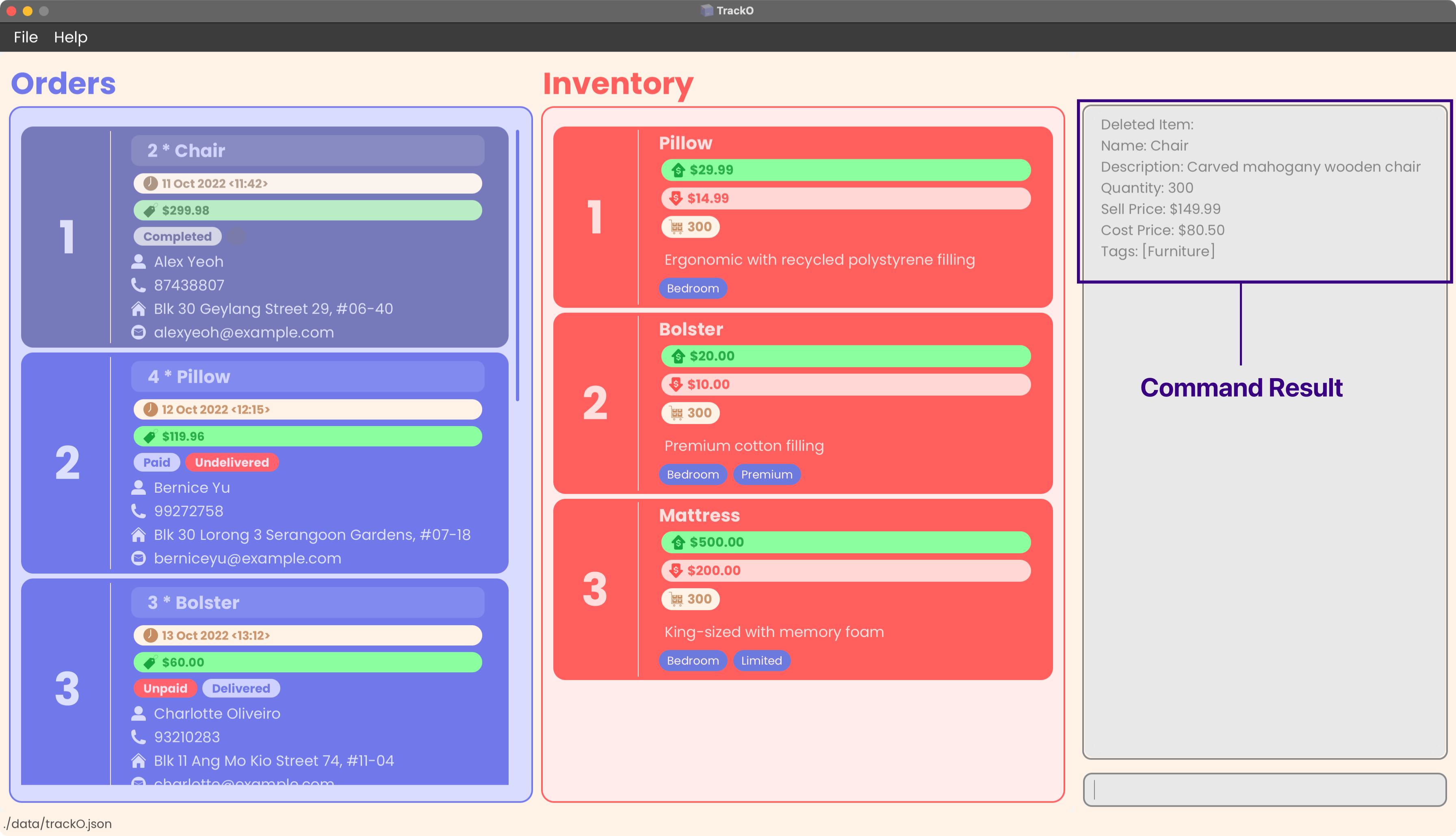
-
When you enter
deletei 2to our sample data, TrackO will remind you that the item you are trying to delete is currently involved in an uncompleted order (in this case, the order at index2). You will not be able to delete the item until the order is completed. To do so, seemarko.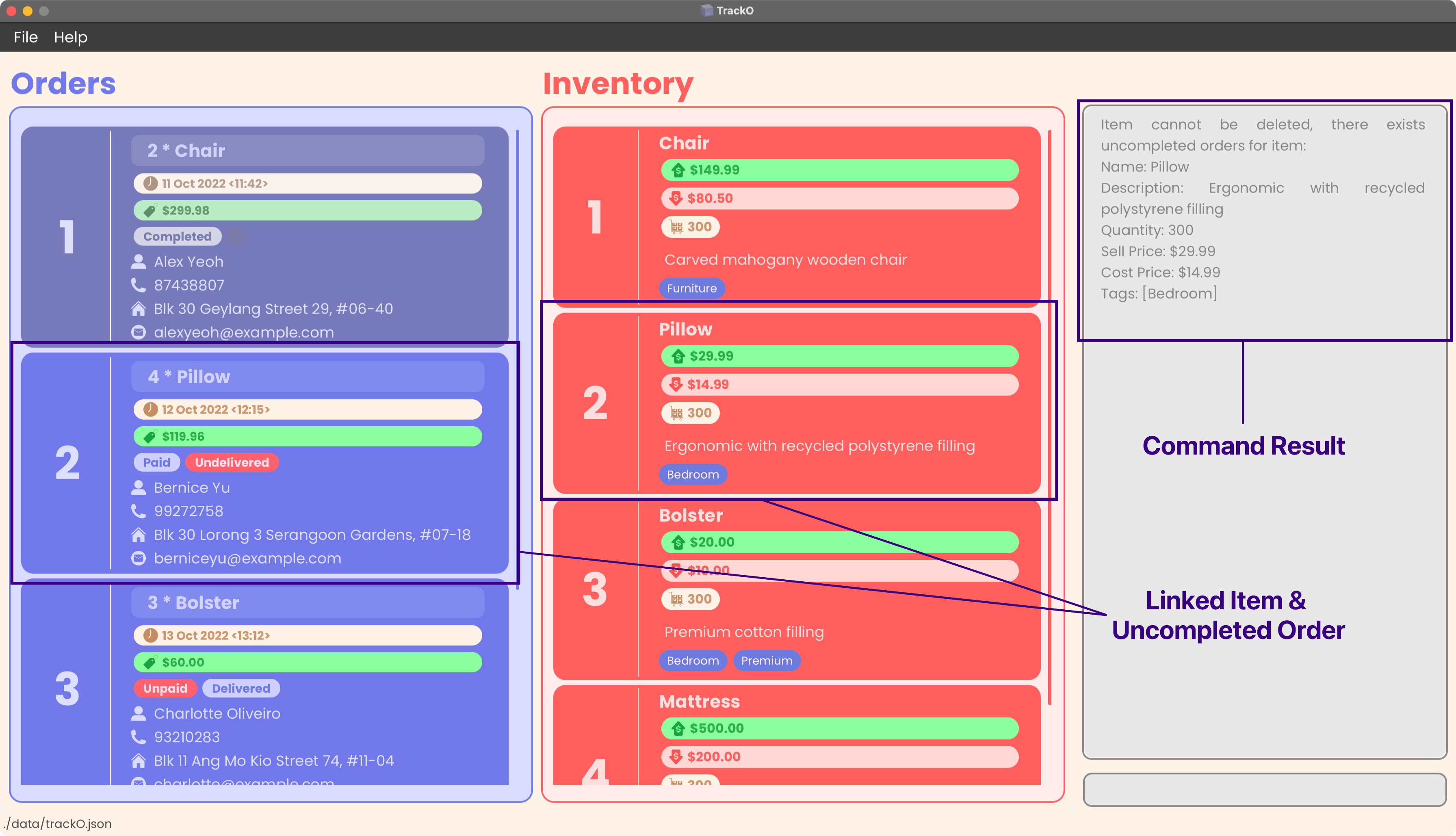
Editing an inventory item: editi
Edits an existing item in the inventory list.
Format: editi INDEX [i/ITEM_NAME] [q/QUANTITY] [d/DESCRIPTION] [sp/SELL_PRICE] [cp/COST_PRICE] [t/TAG]…
![]() Notes:
Notes:
-
Edits the item at the specified
INDEX. -
INDEXrefers to the index number shown in the displayed inventory list. -
INDEXmust be a positive integer 1, 2, 3, … -
You can remove all the item’s tags by typing
t/without specifying any tags after it.
Item is involved in an uncompleted order, you cannot edit its Item Name, Sell Price, and Cost Price.
You can only edit its Quantity, Description, Tag.
Example(s):
-
When you enter
editi 1 i/Table q/200 d/Metal Table t/Fragileto our sample data, TrackO will edit the item name, quantity, description and tag of the 1st item, which wasChair, to beTable,200,Metal TableandFragilerespectively.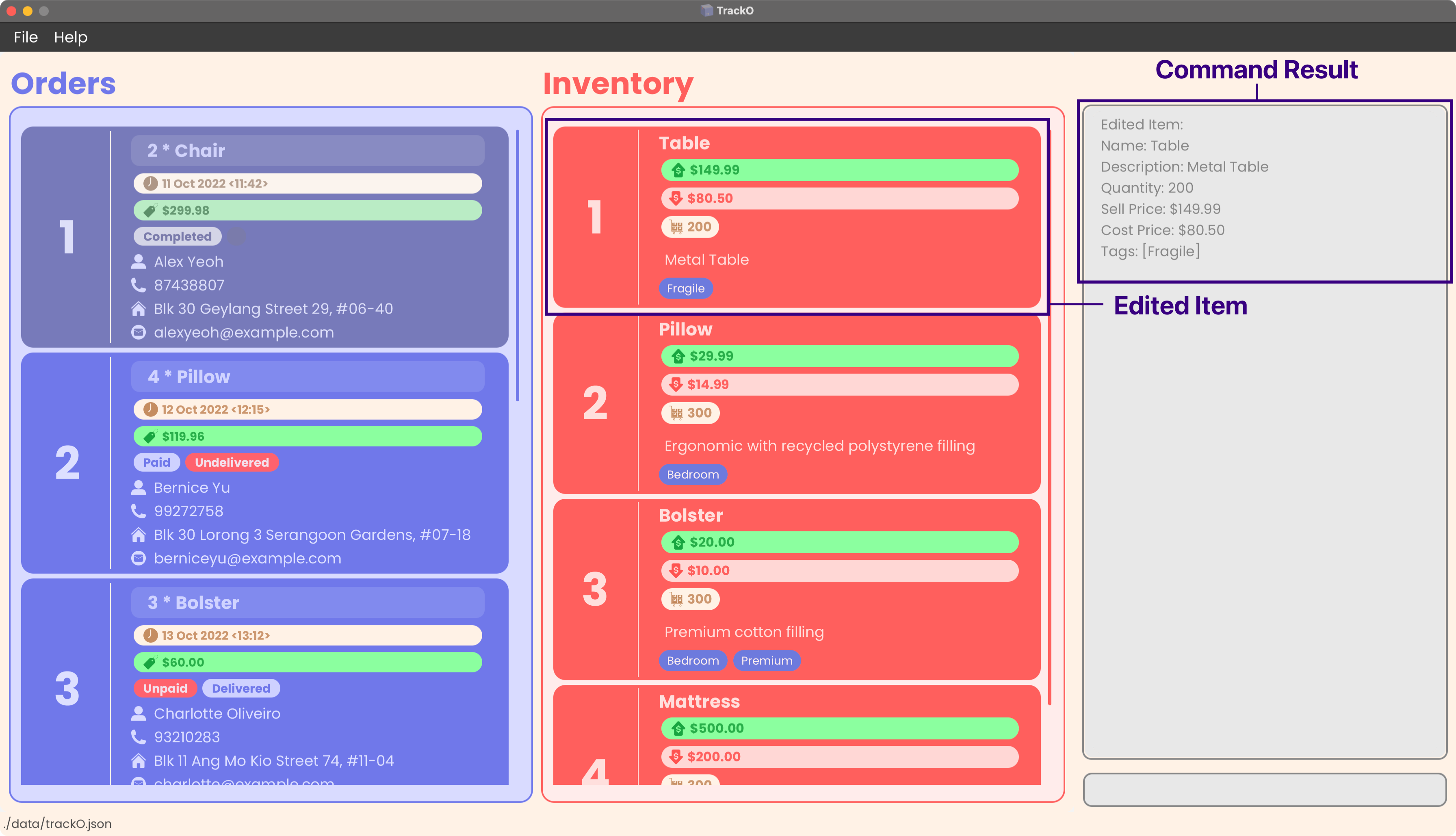
-
When you enter
editi 1 t/, TrackO removes the tags of the item at index1.
-
When you enter
editi 3 i/Cookies d/Delicious home-made cookiesto our sample data, TrackO will remind you that the item you are trying to edit is currently involved in an uncompleted order (in this case, the order at index3) and the item will not be edited.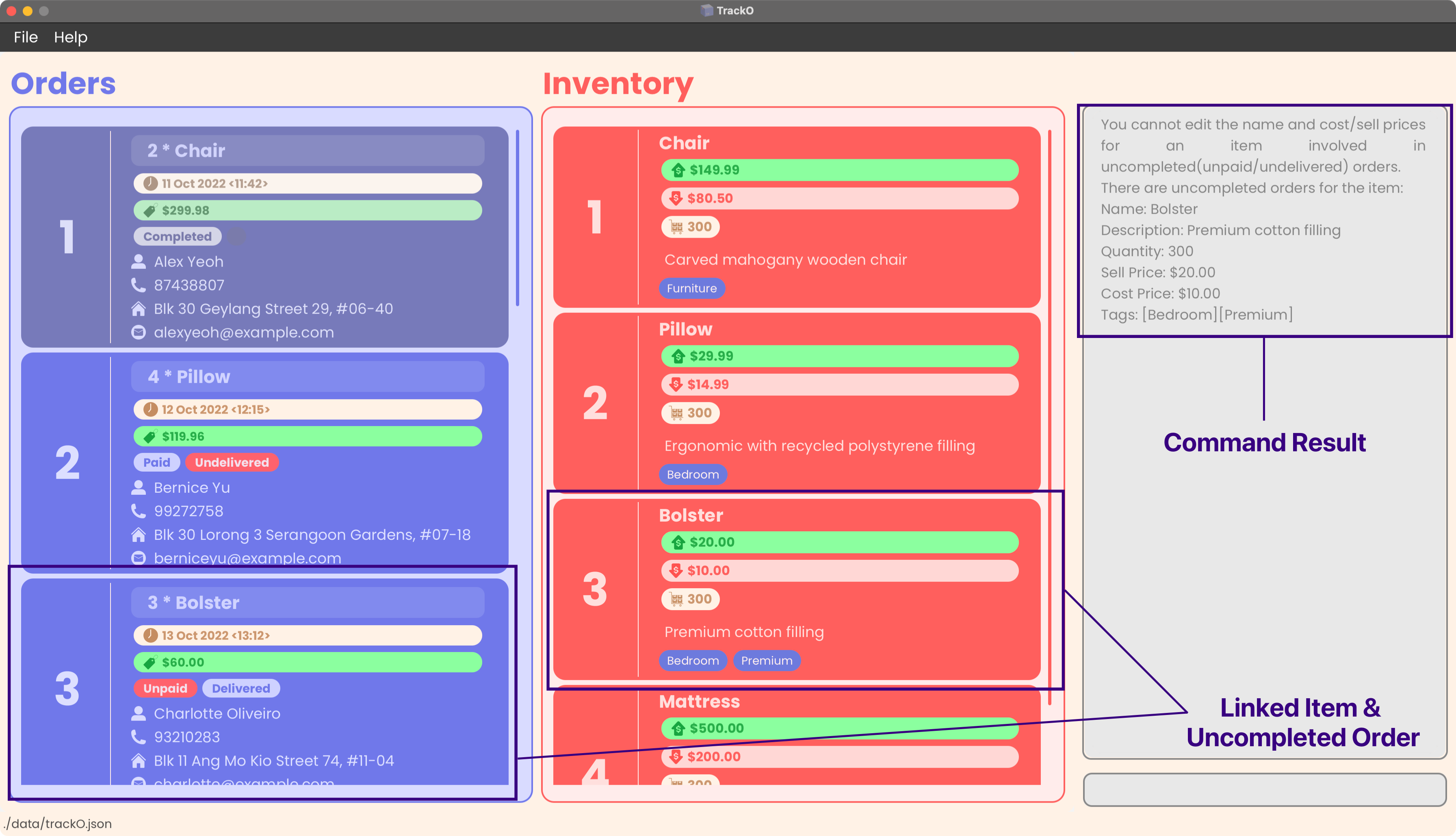
-
When you enter
editi 3 q/500to our sample data, the quantity of the item at index3,Bolster, will be restocked to500units.
Order management
The commands included in this section are related to order management.
As of v1.4, there are 7 commands.
Adding an order: addo
Creates an order to be added to the list of orders tracked by TrackO.
- The added orders will track the time that it was created.
The first step is to initiate the command with the customer’s data.
Format: addo n/NAME p/PHONE e/EMAIL a/ADDRESS
Example(s):
-
addo n/John Doe p/91234567 e/johndoe@example.com a/48 Westwood Terracecreates an order for customerJohn Doe, who is contactable at91234567andjohndoe@example.comand wants the order delivered to48 Westwood Terrace -
addo n/Betty White p/92345678 e/bettywhite@example.com a/39 Ocean Drivecreates an order for customerBetty White, who is contactable at92345678andbettywhite@example.comand wants the order delivered to39 Ocean Drive
The next step is to add the order items and their order quantities to the created order.
Format: i/ITEM_NAME q/QUANTITY
![]() Notes:
Notes:
-
You must input an item name that matches an existing item in your inventory list.
-
The name matching is case-insensitive.
e.g.i/pEn q/3andi/pen q/3will both add3quantities (or units) of the inventory itemPento the created order. -
You must input a quantity of integer value more than 0,
e.g.q/1orq/3but NOTq/0orq/-1. -
If you input an item name that matches previously entered item, the quantity of the added item will be updated instead.
e.g.i/Box q/3followed byi/Box q/4will only add a total of4quantities (or units) ofBoxto the created order
Lastly, to end the command, you can enter done to tell TrackO to track the order or cancel to completely abort the command.
Example(s):
-
When you enter
addo n/John Doe p/91234567 e/johndoe@example.com a/48 Westwood Terrace, followed byi/pillow q/5, then lastlydone, you are creating an order forJohn Doe, who is contactable at91234567andjohndoe@example.comand wants5 Pillowsdelivered to48 Westwood Terrace. Executing this command to our sample data will display the following result: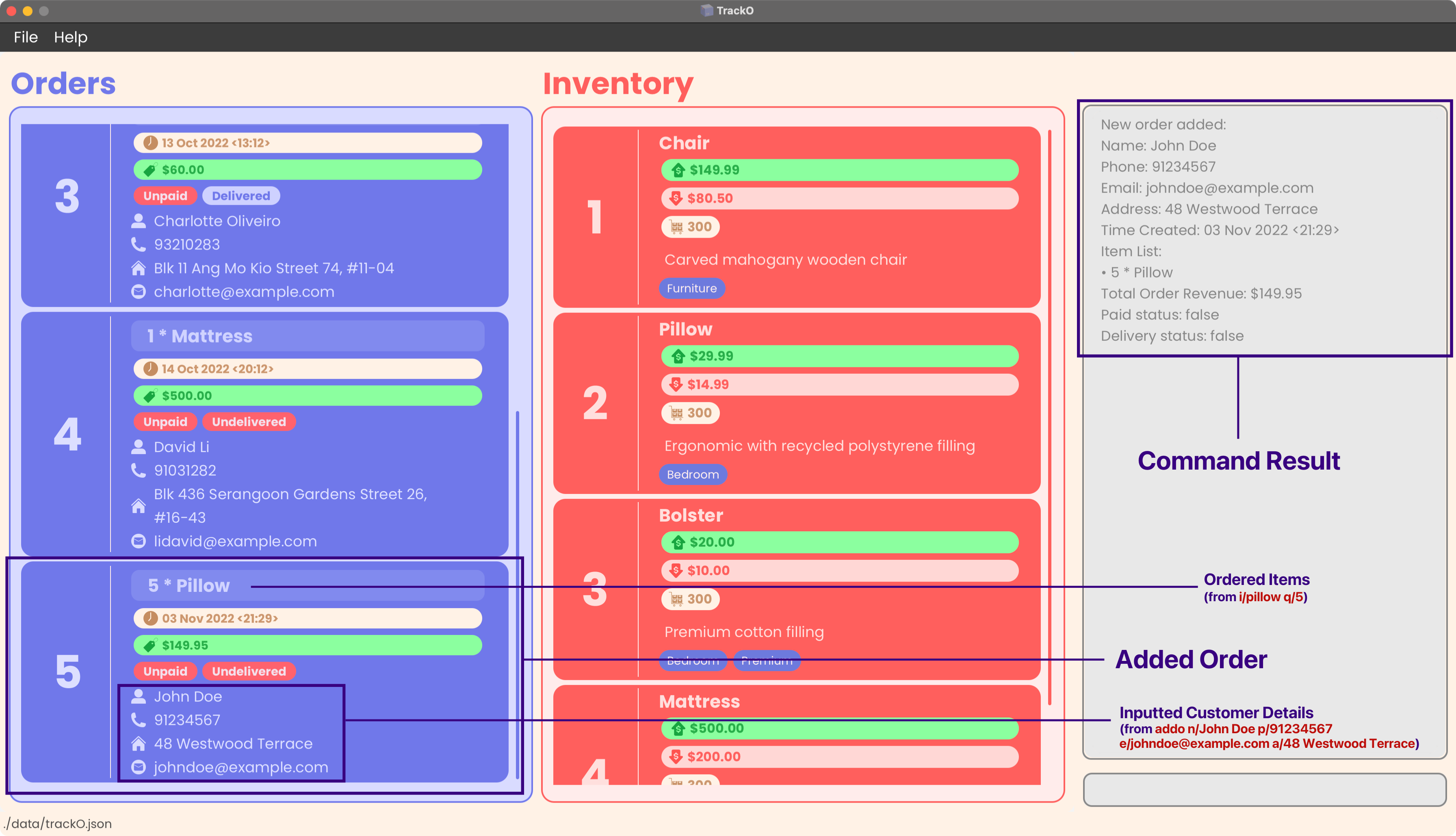
Listing all orders: listo
Lists all the orders a store has.
Format: listo
Example(s):
-
When you enter
listoto our sample data, TrackO will list all the existing orders in the order list. Executing it on our sample data will display the following result:
Finding order(s): findo
Finds order(s) according to input flags/keywords.
Format: findo [-d OR -D] [-p OR -P]
[i/ITEM_KEYWORD [MORE_ITEM_KEYWORDS]]
[a/ADDRESS_KEYWORD [MORE_ADDRESS_KEYWORDS]]
[n/NAME_KEYWORD [MORE_NAME_KEYWORDS]]
- All 4 flags (
-d,-D,-p,-P) are optional.-
-d: search for orders which are delivered -
-D: search for orders which are not delivered -
-p: search for orders which are paid -
-P: search for orders which are not paid
-
- There are 3 prefixes (
a/,n/,i/). If there are no flags present, at least one of the 3 prefixes must be used.-
a/: searches by address -
n/: searches by name -
i/: searches by order item
-
- A prefix is only expected once in the command but if specified multiple times, only the last occurrence of
the parameter will be taken in, e.g.
findo a/Clementi a/Geylangwill search for orders withGeylangin their address.
![]() Notes:
Notes:
-
The search keywords used are case-insensitive.
e.g.keychainwill matchKeychain -
The order of the keywords does not matter.
e.g.findo a/Geylang n/Alexwill also give the same results asfindo n/Alex a/Geylang -
Only full words will be matched.
e.g.Gardens,will not matchGardensandkeychainwill not matchkeychains -
Orders matching at least one keyword will be displayed.
e.g.findo i/apple keychainwill displayapple paintingandbanana keychain
Example(s):
-
When you enter
findo n/Alex a/Geylang, TrackO will display all orders with the nameAlexand an address including the wordGeylang. Executing it on our sample data will display the following result: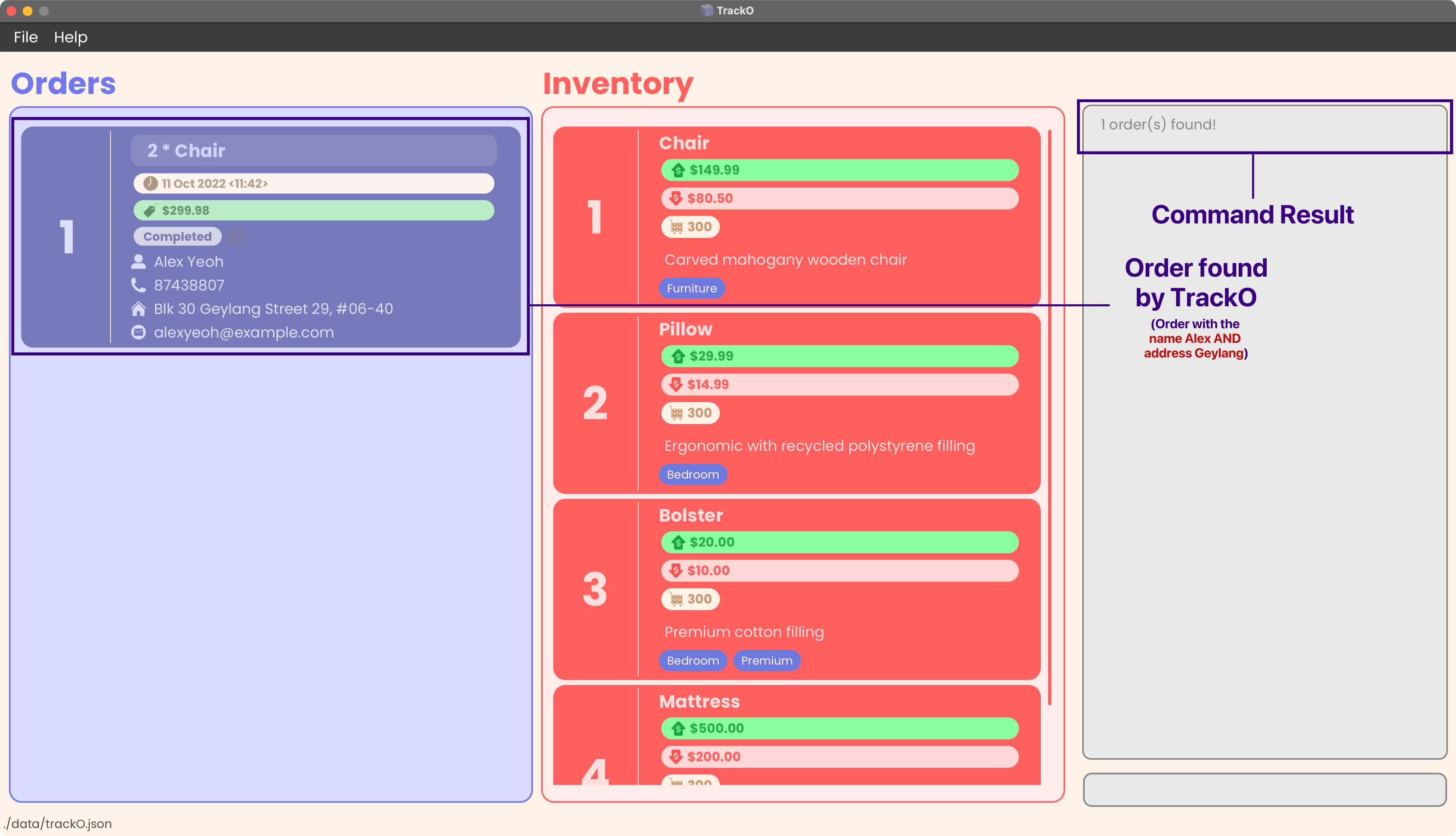
-
When you enter
findo n/Charlotte Bernice a/Serangoon Ang Mo Kio, TrackO will display all orders with the nameCharlotteorBerniceand an address including the wordSerangoonorAng Mo Kio. Executing it on our sample data will display the following result: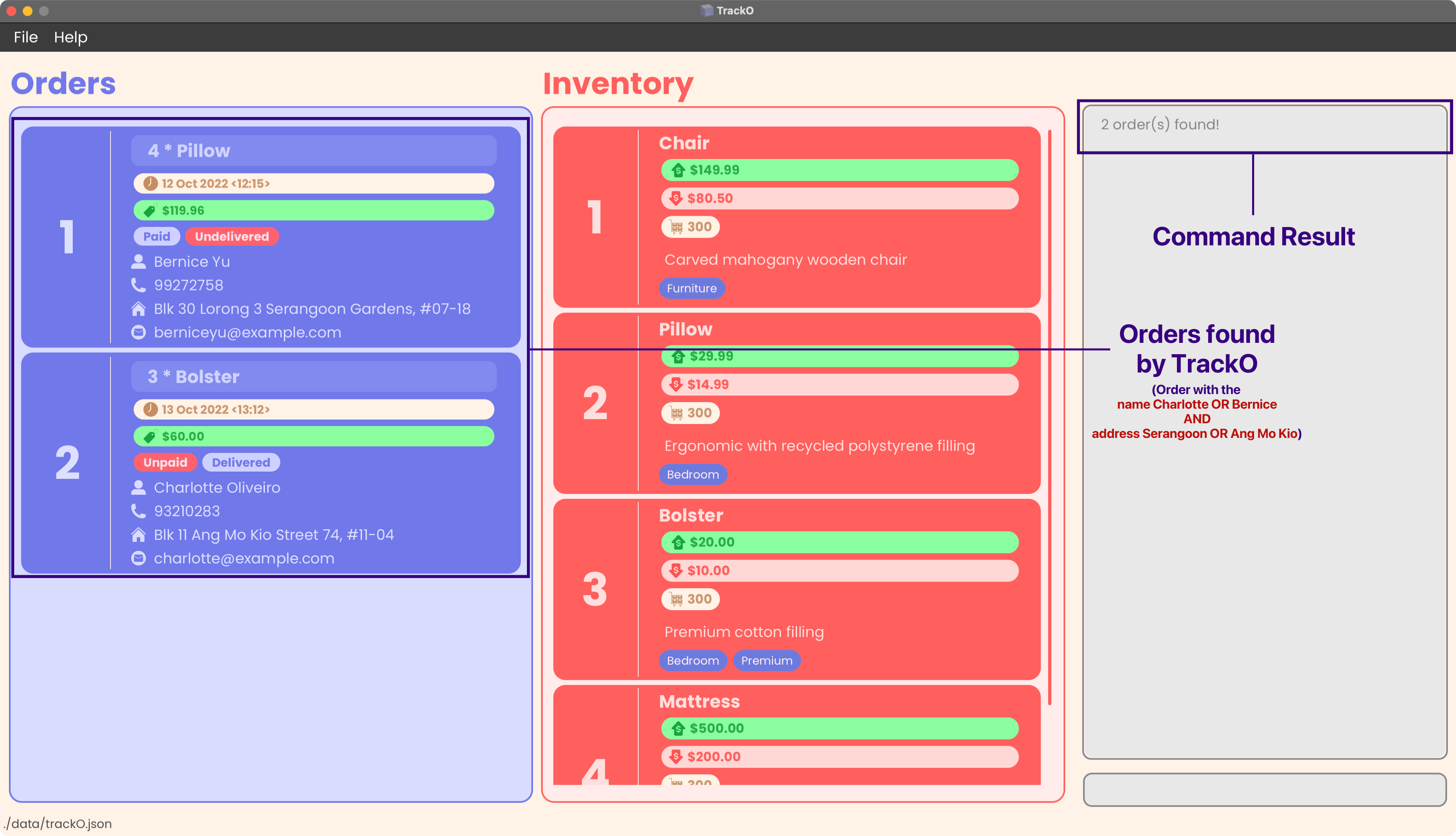
-
When you enter
findo -d n/Charlotte, TrackO displays all orders with the nameCharlottewhich have been marked asdelivered. Executing it on our sample data will display the following result: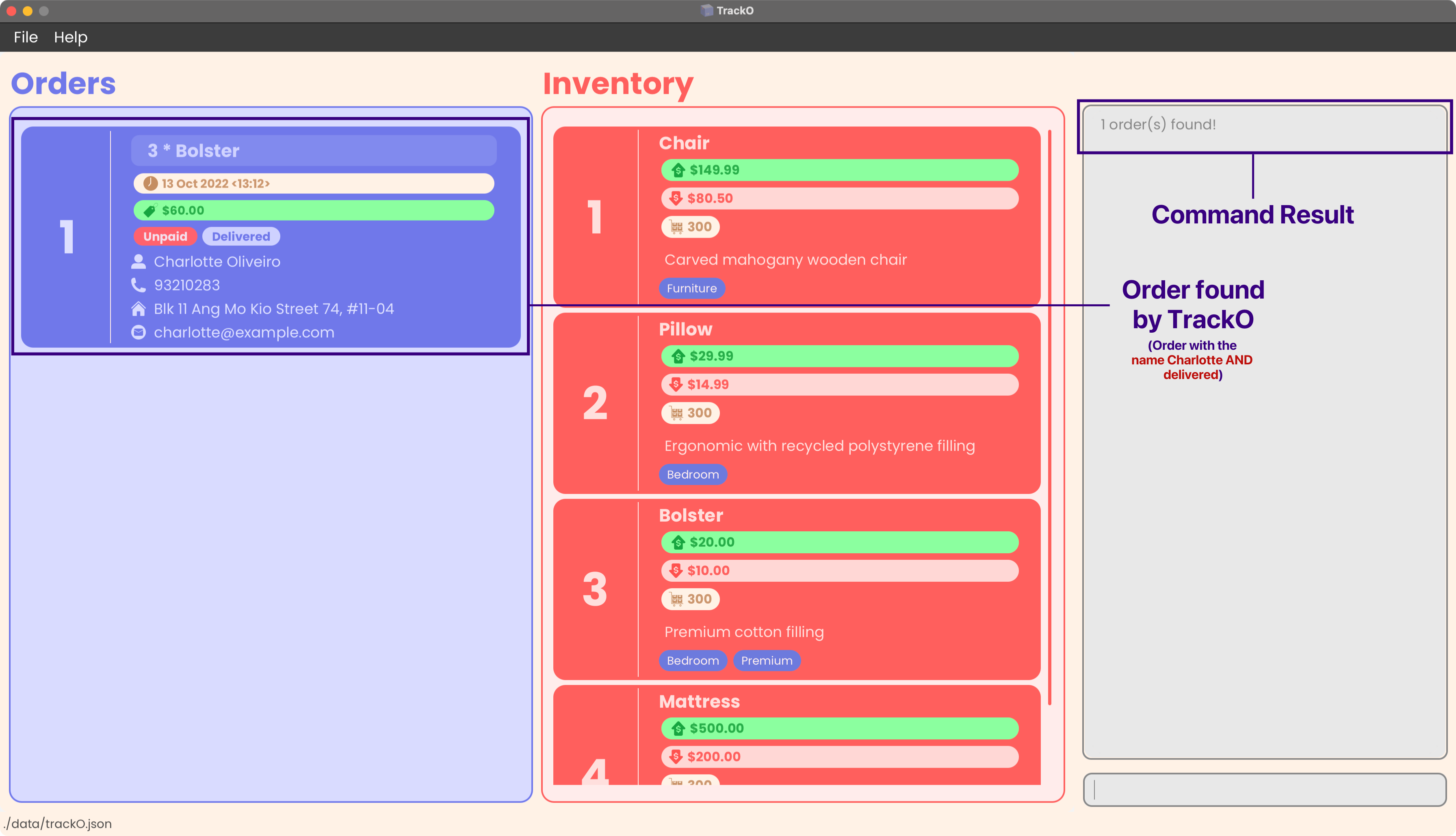
-
When you enter
findo -d -p n/Alexdisplays all orders with the nameAlexwhich have been marked aspaidanddelivered. Executing it on our sample data will display the following result: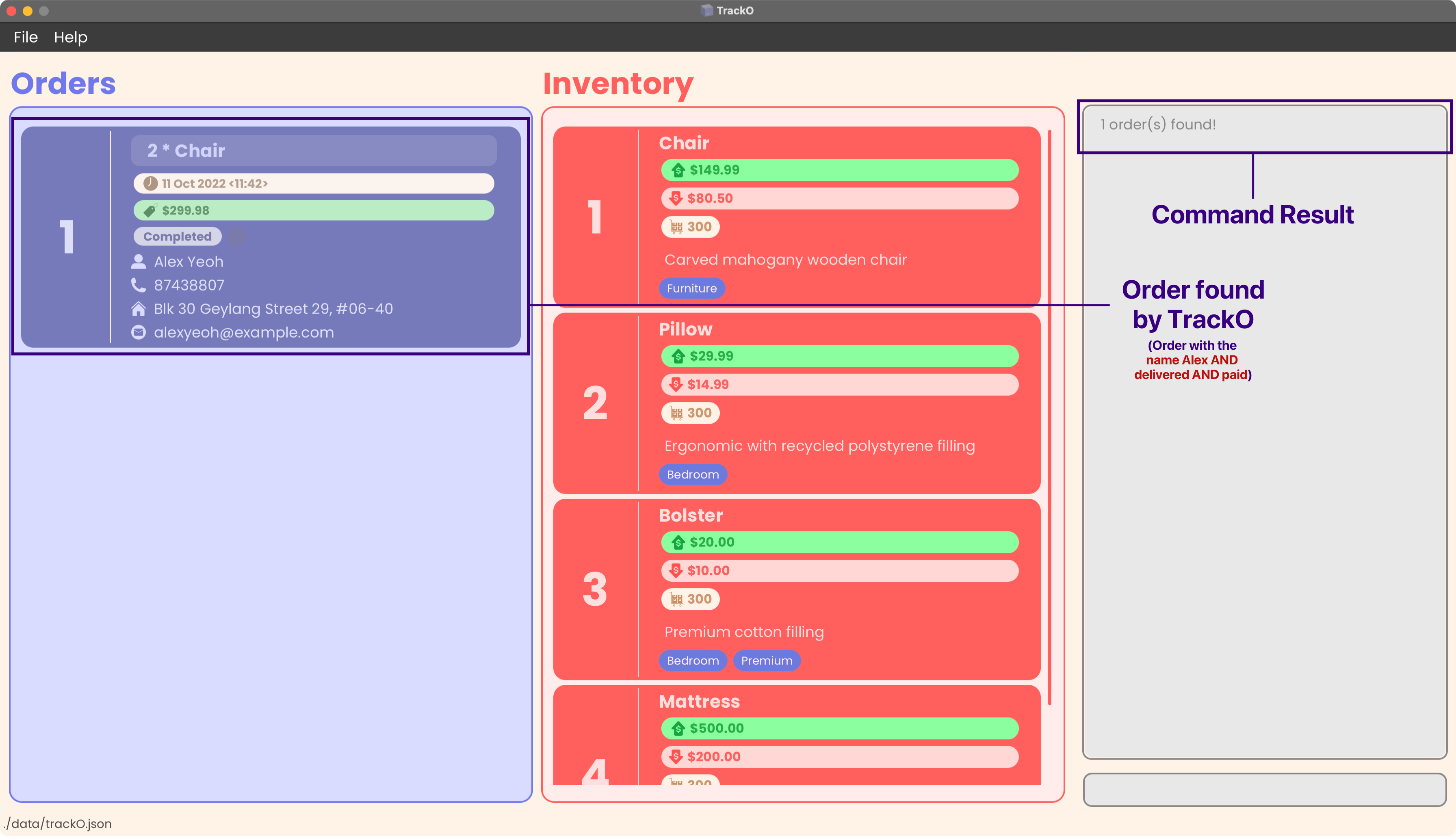
-p and -d to find completed orders!
Sorting orders by time created: sorto
Sorts the displayed list of orders by the time at which they were created.
Format: sorto new or sorto old
- The keywords
newandoldare case-insensitive. -
sorto newsorts the order list such that the newest orders are at the top. -
sorto oldsorts the order list such that the oldest orders are at the top.
Example(s):
-
When you enter
listofollowed bysorto old, TrackO sorts all orders such that oldest orders are at the top. Executing it on our sample data will display the following result:
-
For this example, let us follow the steps described below:
-
First, enter
addo n/Jessica Doe a/Blk 12 Changi Road 20, #01-15 p/90876543 e/jessicadoe@gmail.com, followed byi/Chair q/5, thendoneto add an order of5 Chairsfor customerJessica Doe. The application will display the following result: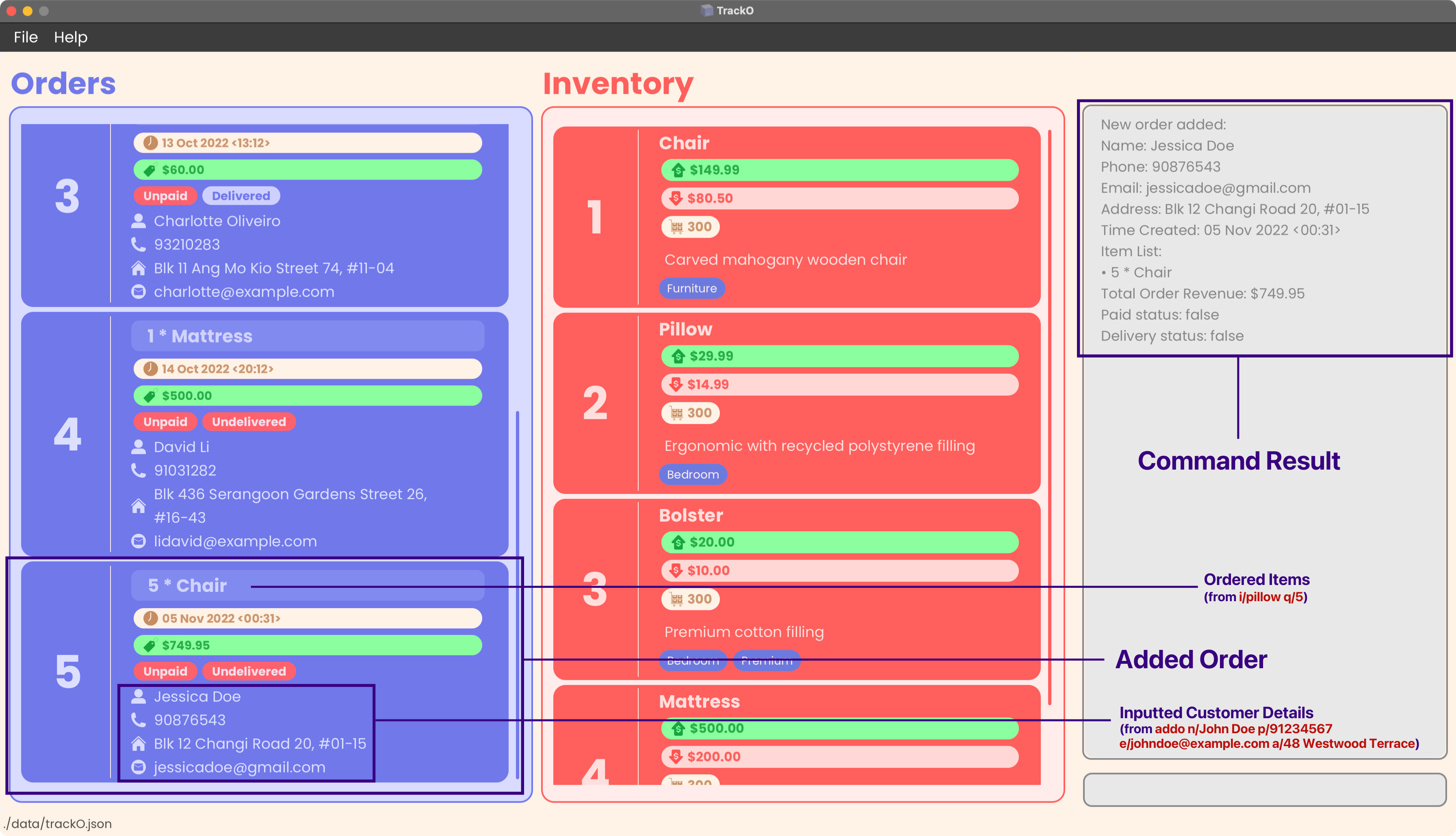
-
Next, enter
findo i/Chairto display all the orders that haveChairin their list of ordered items. The application will display the following result:
-
When you enter
sorto new, the currently displayed orders will be sorted from the newest to the oldest. The application will display the following result: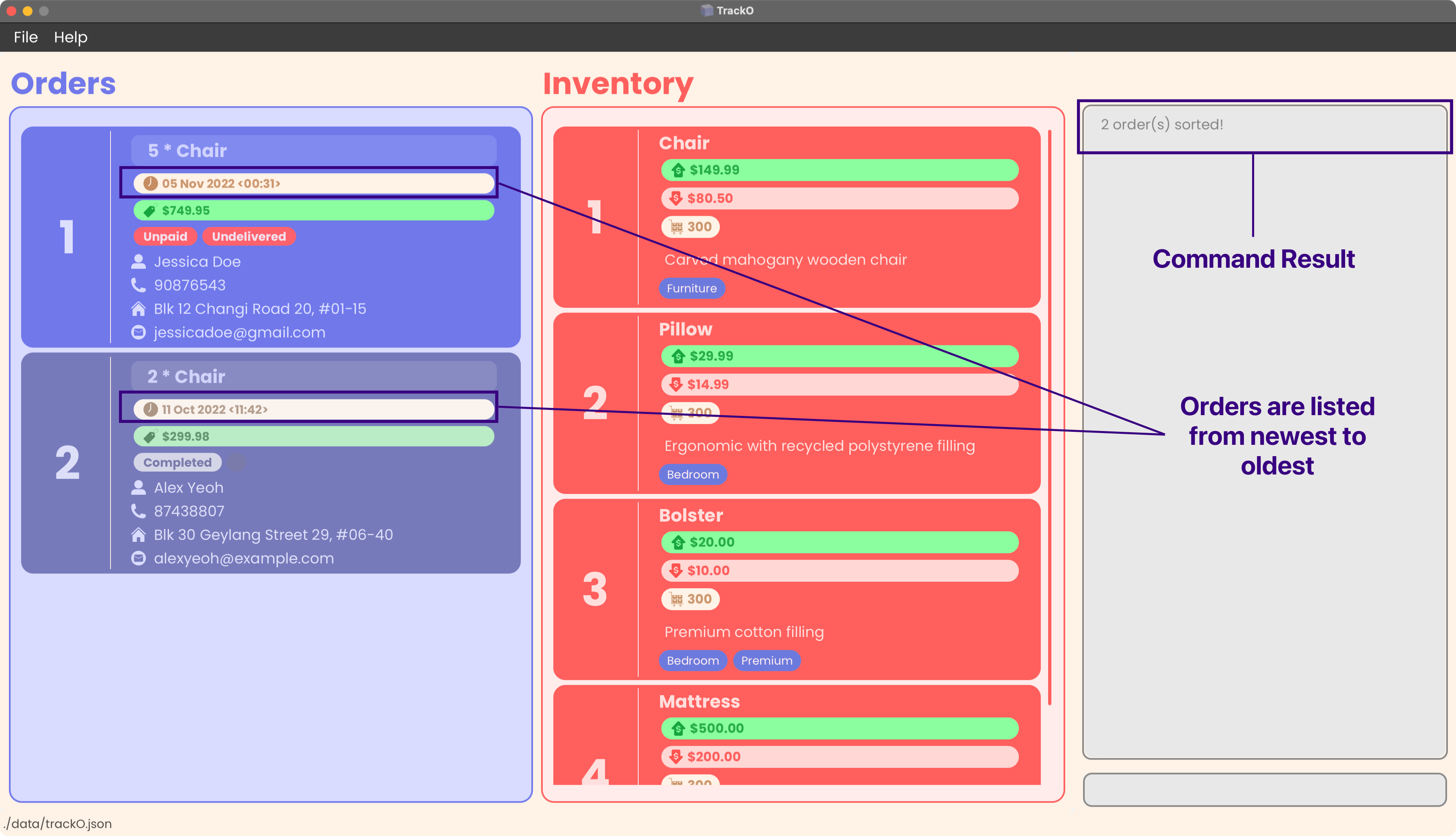
-
Deleting an order: deleteo
Deletes an order from the list of tracked orders.
Format: deleteo INDEX
- Deletes the order at the specified
INDEX. -
INDEXrefers to the index number shown in the displayed order list. -
INDEXmust be a positive integer 1, 2, 3, …
Example(s):
-
When you enter
listofollowed bydeleteo 2, TrackO deletes the 2nd order from the order list. Executing it on our sample data will display this result: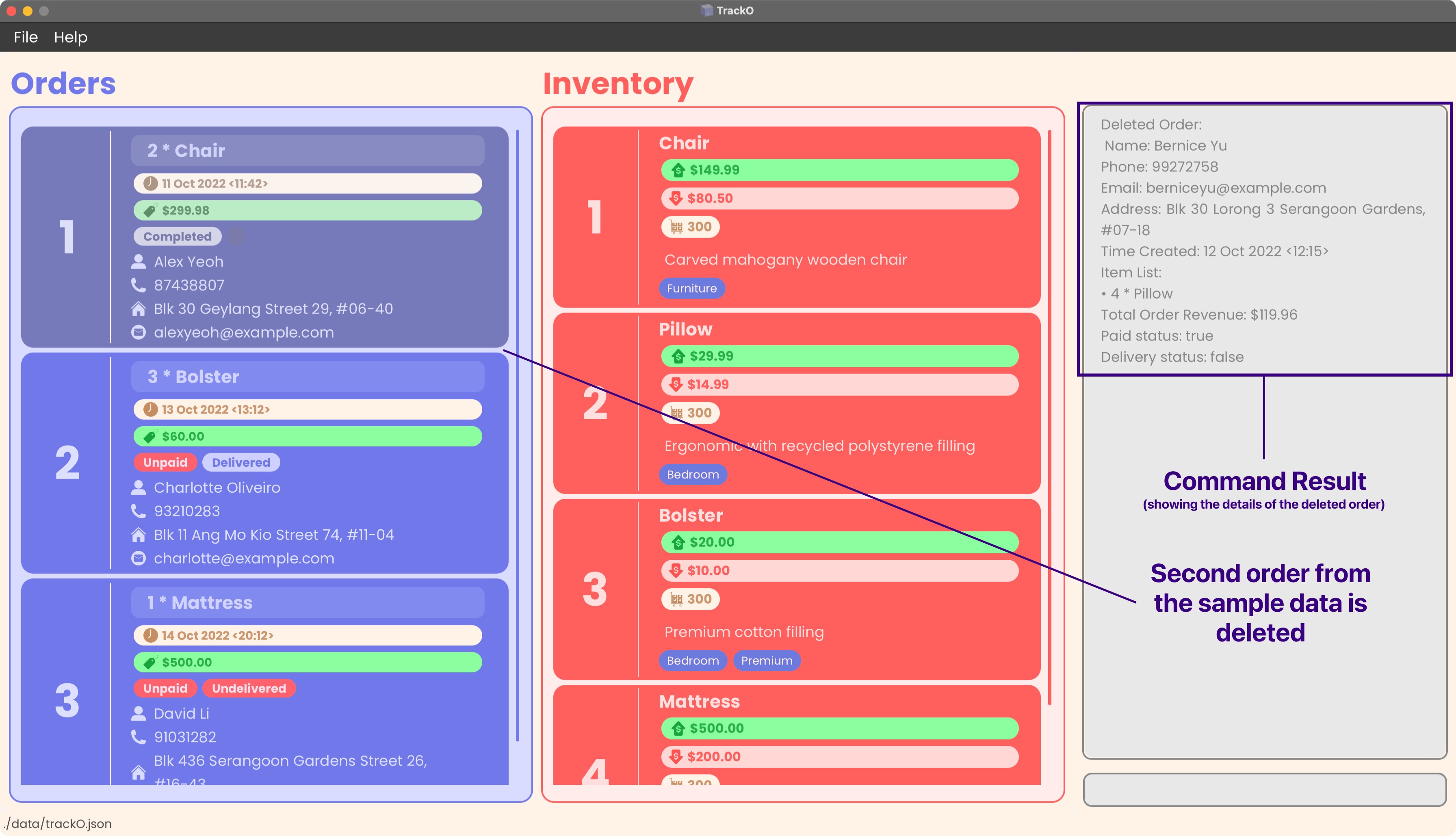
- For the second example, let us follow the steps described below:
-
First, enter
findo i/Pillow. TrackO will display orders with the itemPillowin their list of ordered items.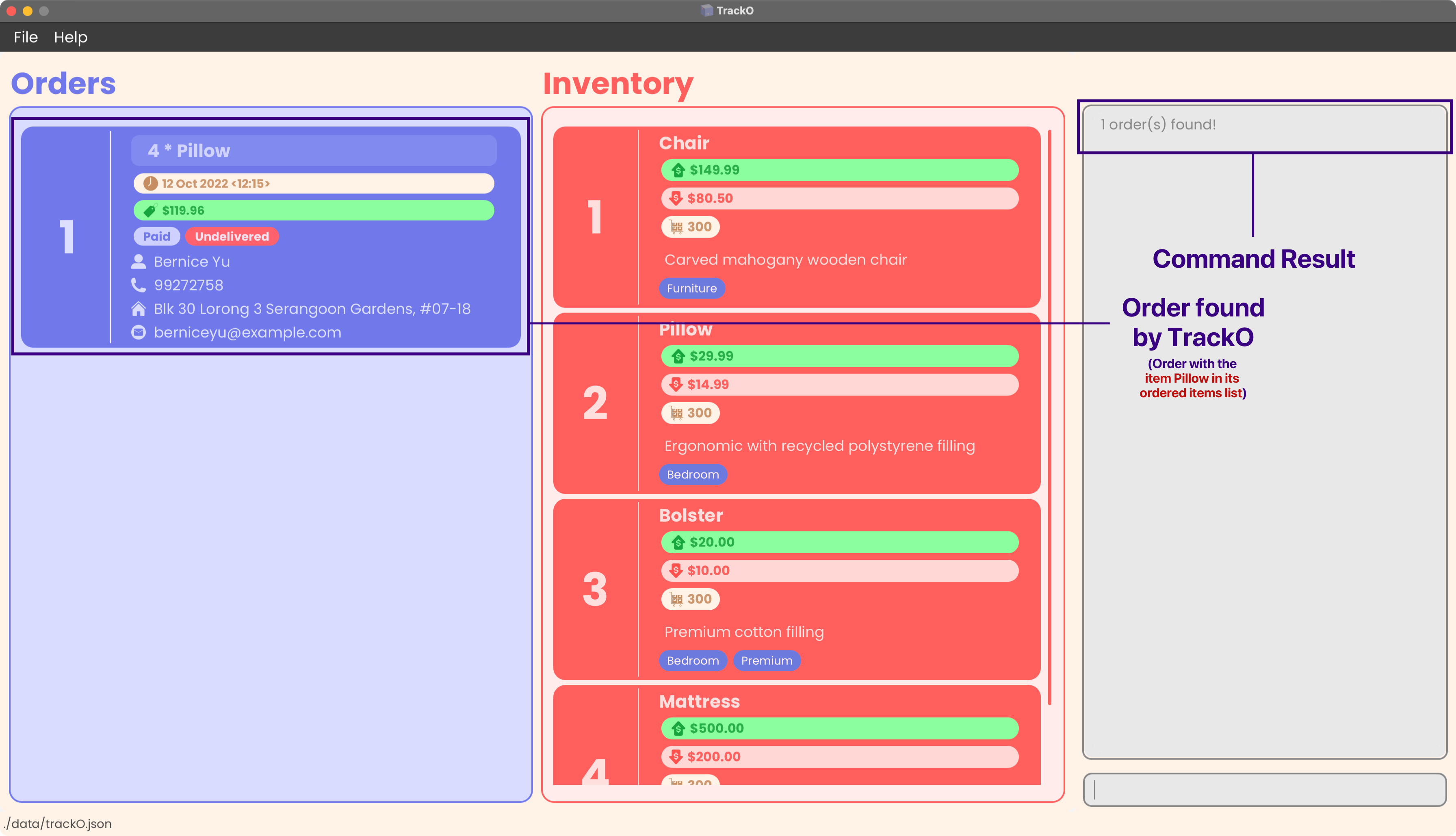
-
When you enter
deleteo 1, TrackO will delete the order currently displayed at index1, which is the order withPillowin its list of ordered items. It will display the following result: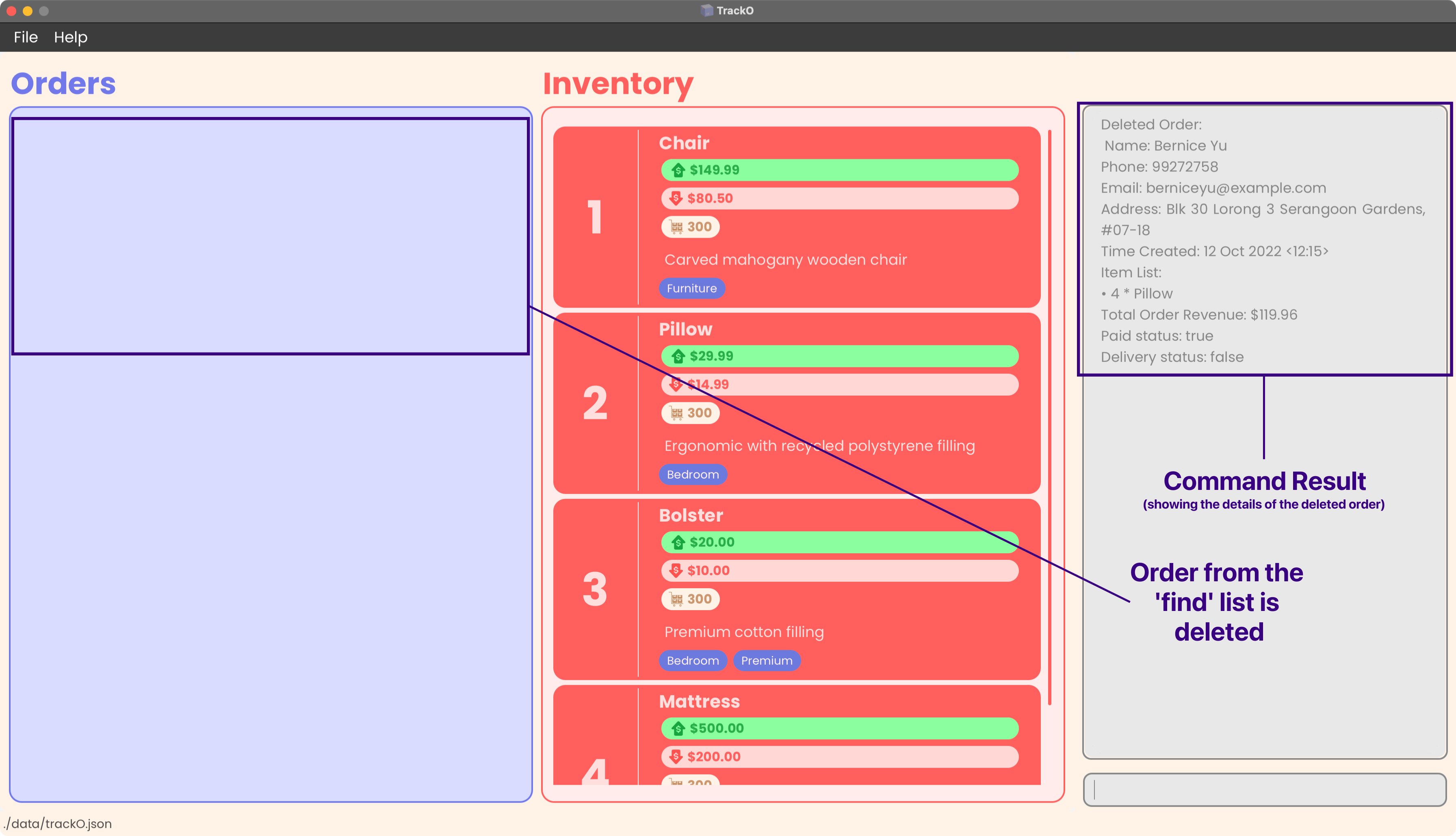
-
To redisplay all your existing orders, enter
listoand it should look like the following: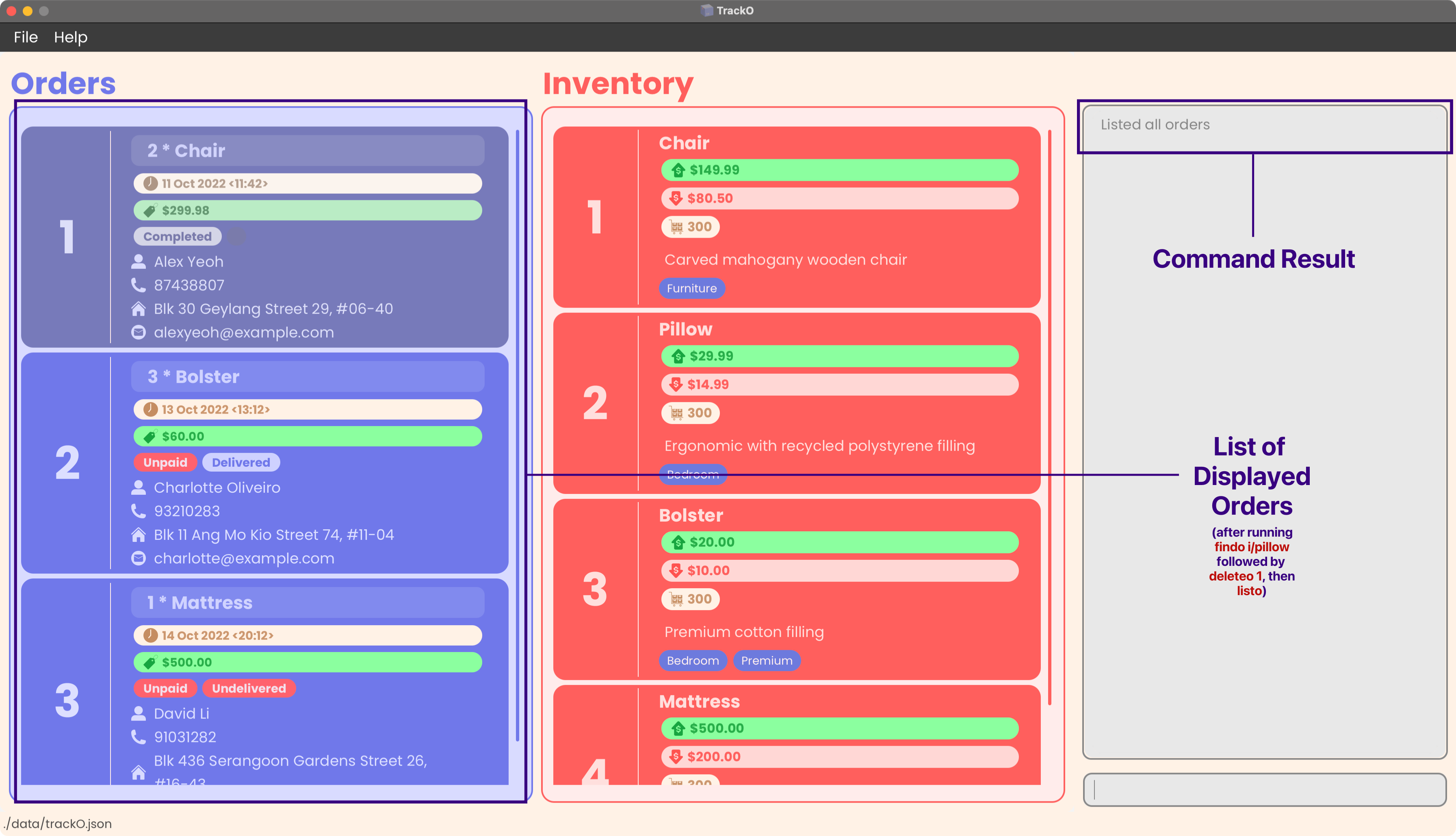
-
- For the third example, let us follow the steps described below:
-
First, enter
sorto new. TrackO will sort the orders from the newest to the oldest, with the most recent order at the top.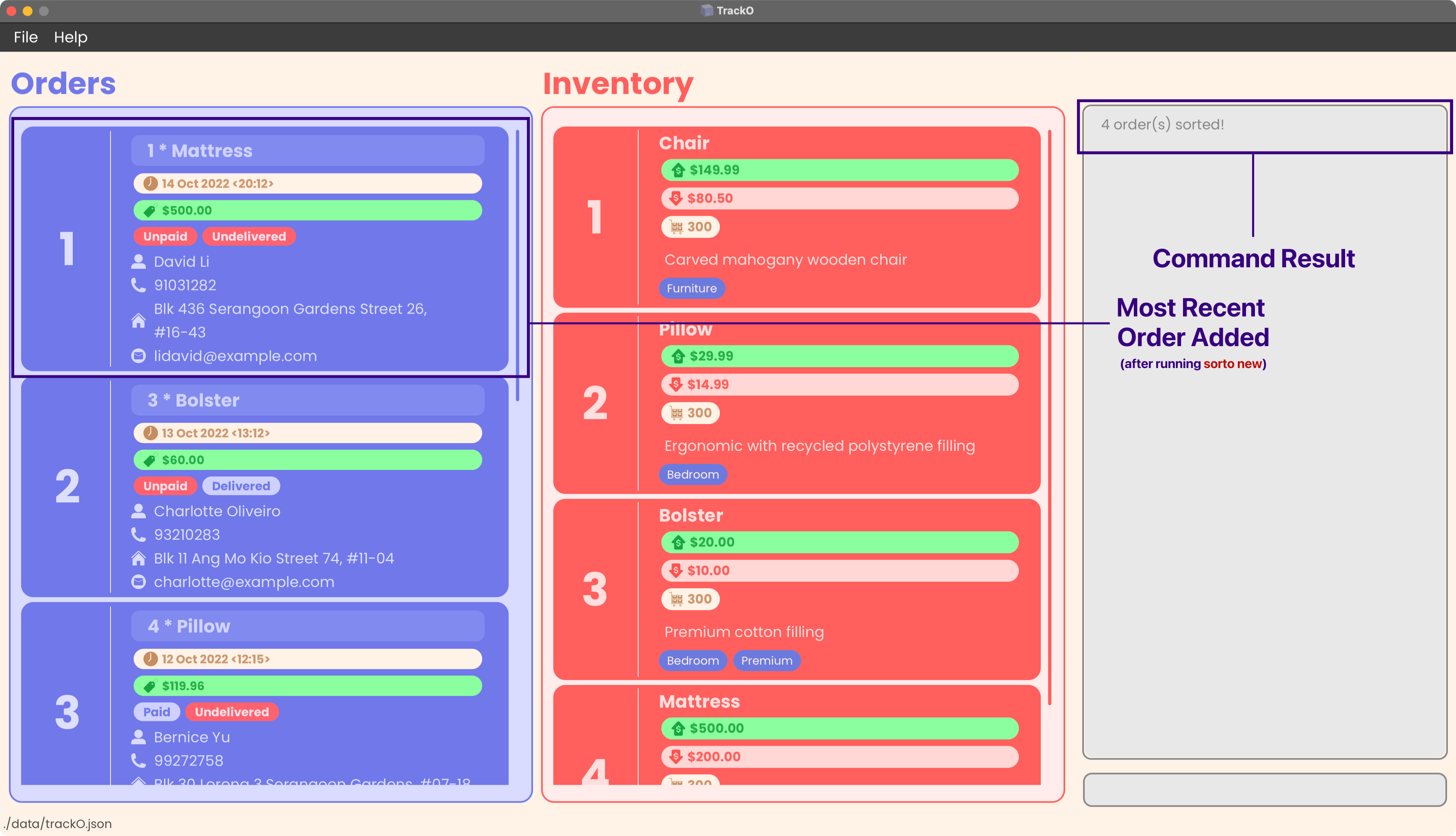
-
When you enter
deleteo 1, TrackO will delete the order currently displayed at index1, i.e. the most recent order.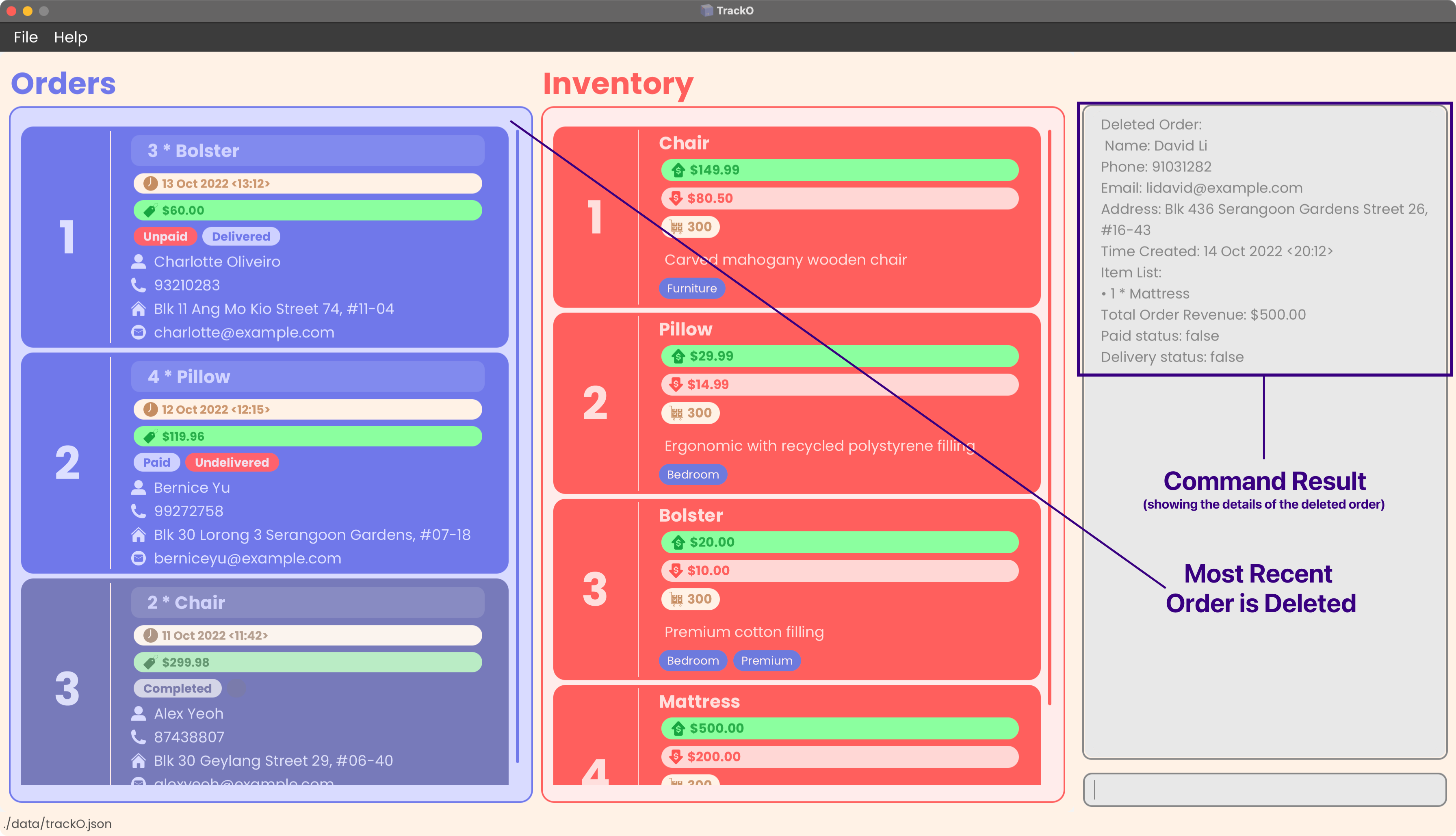
-
Editing an order: edito
Edits an existing order in the order list.
Format: edito INDEX [n/NAME] [p/PHONE] [e/EMAIL] [a/ADDRESS] [i/ITEM_NAME q/QUANTITY]
- Edits the order at the specified
INDEX. - This feature is case-insensitive.
- The
INDEXrefers to the index number shown in the displayed order list. - The
INDEXmust be a positive integer 1, 2, 3, … - Every field is optional, but if you were to include
i/ITEM_NAME, you must also includeq/QUANTITY. Both fields need to be present to update an order’s list of ordered items. - You can only edit an order’s list of ordered items to consist of items that exists in your inventory.
e.g. If your inventory does not haveApples, then you cannot edit any of your order’s list of ordered items toApples. - Editing an item that does not exist in your order’s list of ordered items, but exists in your inventory
will add the item to the order’s list of ordered items.
e.g. Your inventory hasApplesandBananas. Right now, the third order’s list of ordered items only hasApples.edito 3 i/Bananas q/3will add3Bananasto the third order’s list of ordered items. - Setting
q/0to any item in the order’s list of ordered items will remove the item from the list.
e.g. The fourth order’s list of ordered items has2Applesand3Bananas. Inputtingedito 4 i/Bananas q/0will remove theBananasfrom the fourth order’s list of ordered items, leaving only the2Apples.
![]() Notes:
Notes:
-
Only orders which are not marked as
paidordeliveredcan be edited. -
The order’s created time cannot be edited.
-
An order’s paid status and delivery status also cannot be edited through this command. To modify those, see
markoinstead.
Example(s):
- For this example, let us follow the steps described below:
-
When you enter
edito 2 n/Peter p/98765432 e/peter@email.com a/123 Apartment Unit, #05-11, TrackO will edit the name, phone, email, and address of the second order in the list toPeter,98765432,peter@email.com, and123 Apartment Unit, #05-11respectively. It will display this result when executed on our sample data: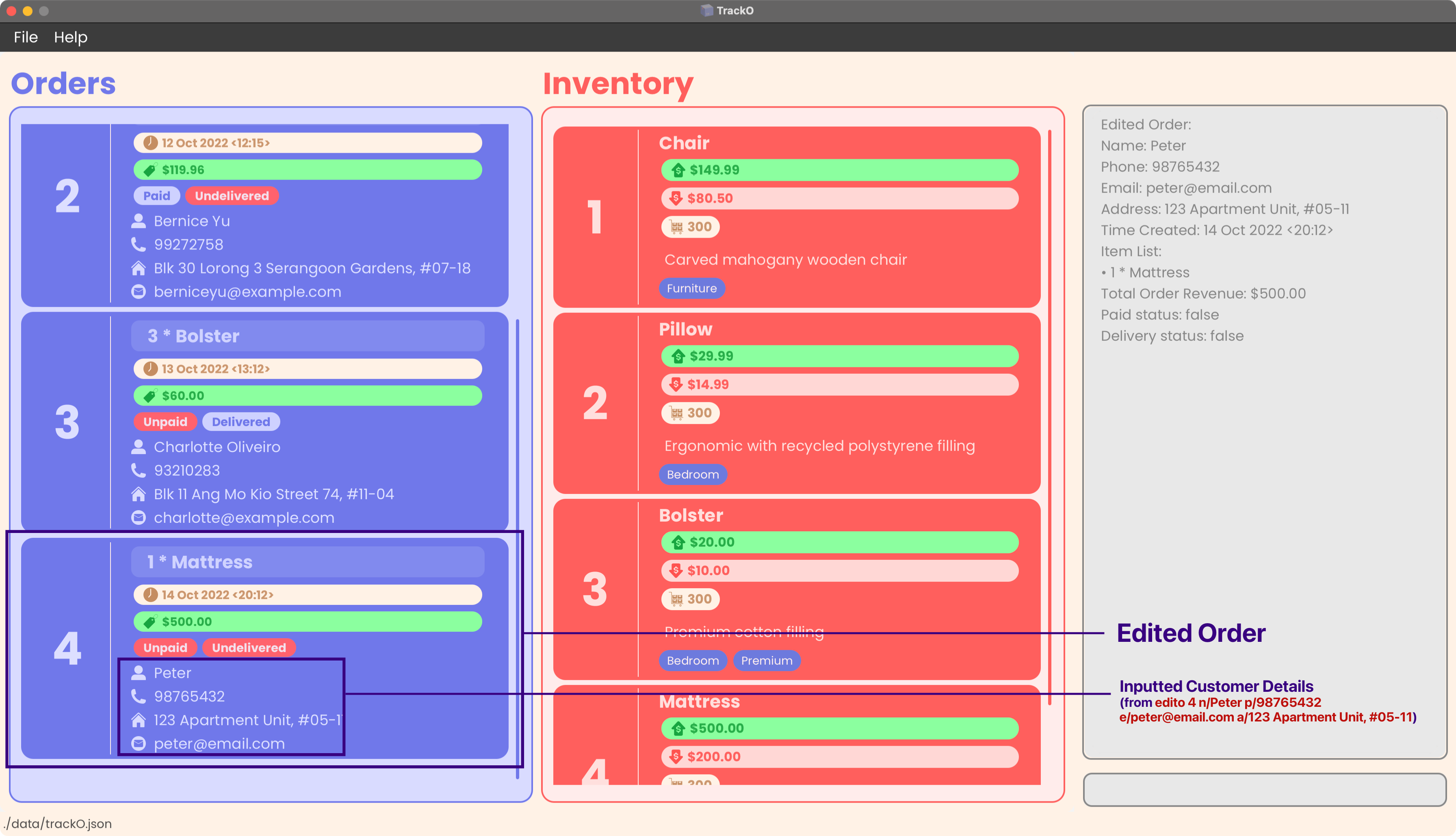
-
Next, entering
edito 4 i/Chair q/5will add5 Chairsto the fourth order’s list of ordered items, as shown below: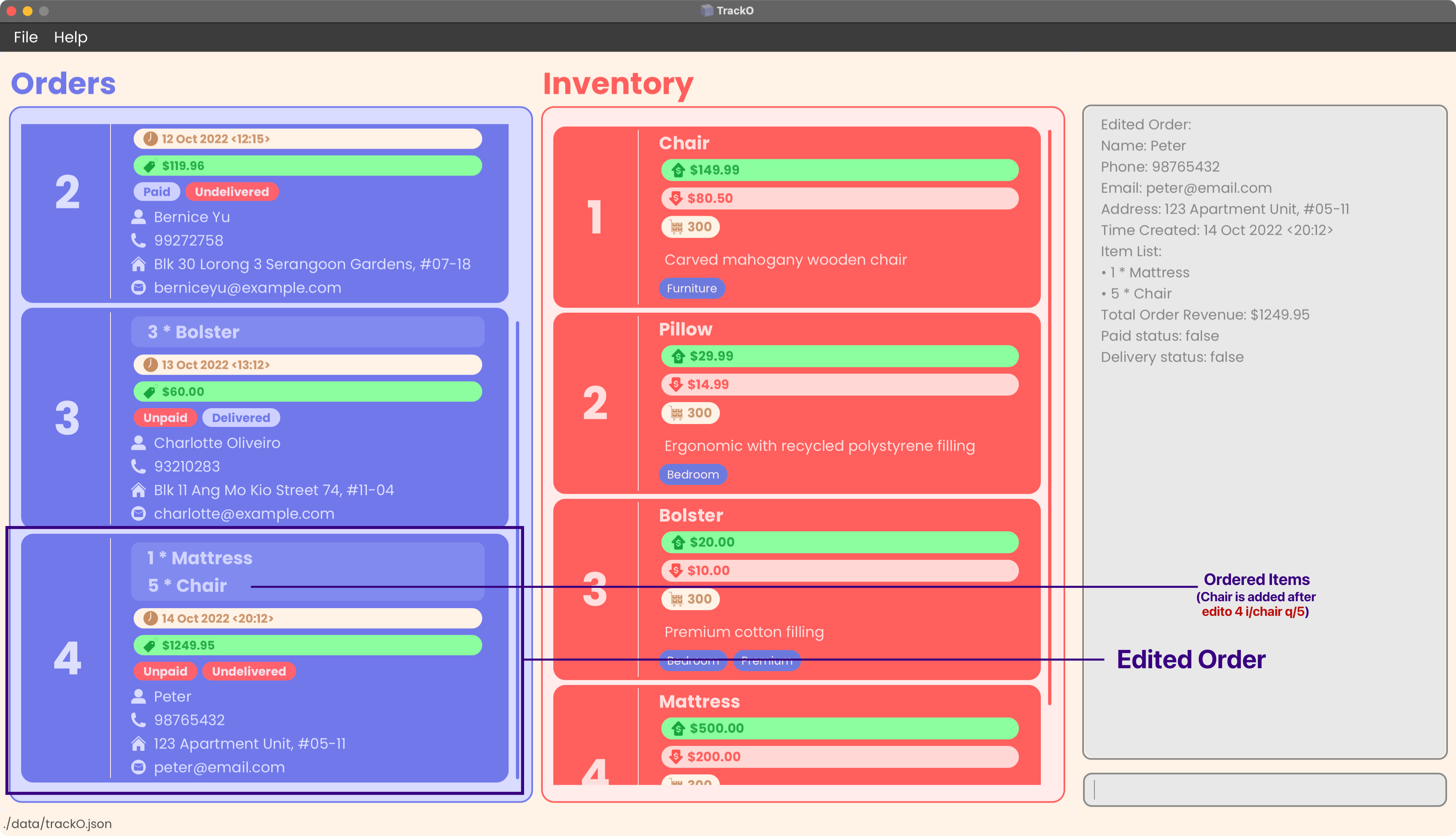
-
Now, let us try entering
edito 4 i/mattress q/0. Doing this will remove the itemMattressfrom the fourth order’s list of ordered items.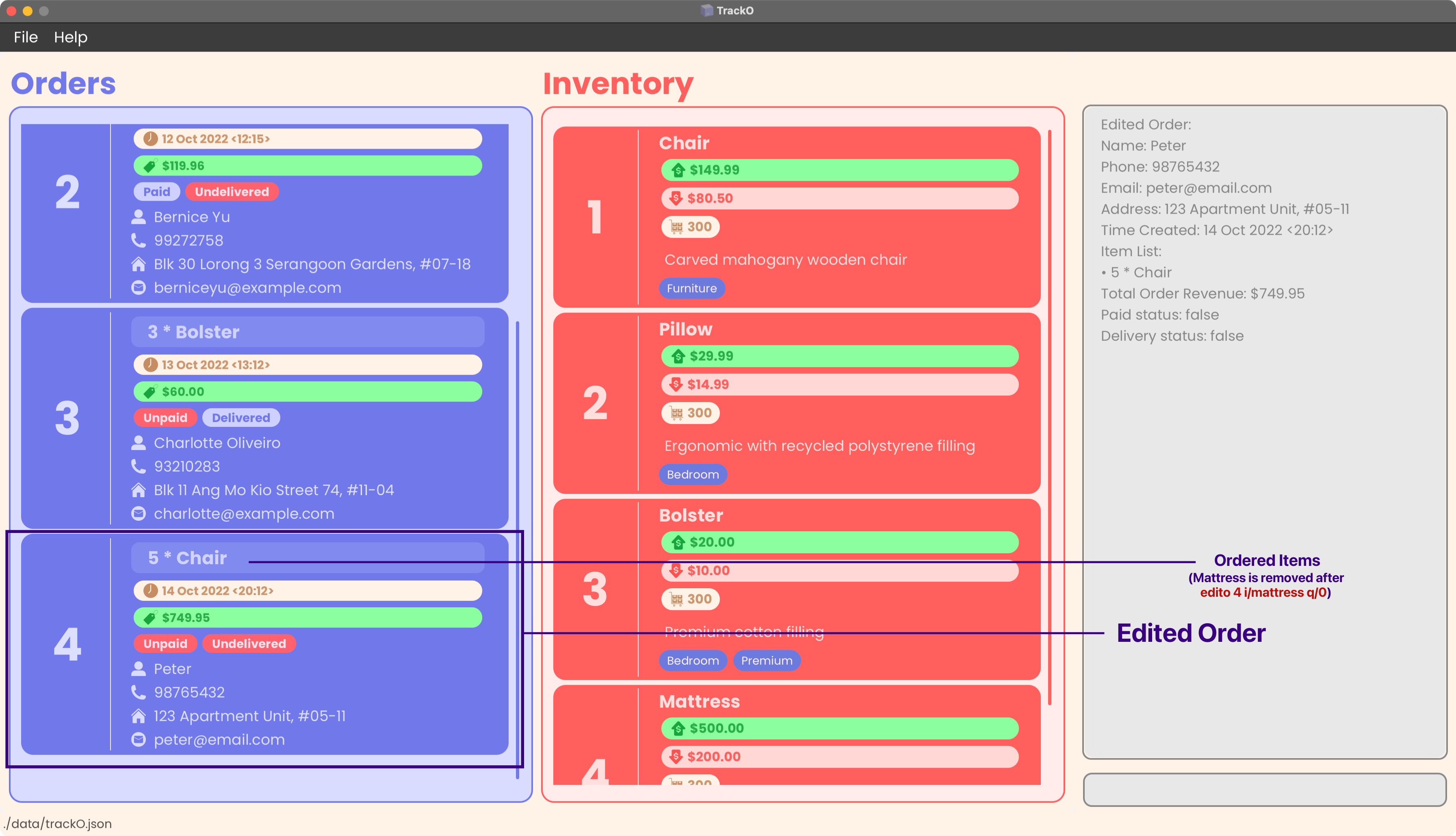
-
Finally, try entering
edito 4 i/Chair q/10. TrackO will update the quantity of orderedChairsin the fourth order to10.
-
Marking an order as paid/delivered: marko
Marks an existing order in the order list as paid and/or delivered.
marko is irreversible. This means that you cannot unmark an order that is marked as
paid and/or delivered.
Format: marko INDEX [-p] [-d]
- Marks the order at the specified
INDEXas paid and/or delivered. - The
INDEXrefers to the index number shown in the currently displayed list. - The
INDEXmust be a positive integer 1, 2, 3, … - Flag
-pmarks the order as paid. - Flag
-dmarks the order as delivered. - Flags are case-sensitive and specific to the character.
e.g.- pis not a valid flag because there is a space between the-andp. - At least one of
-por-dmust be present in your input. - Both
-pand-dmay be present in your input to mark an order as both paid and delivered. - When an order is completed (marked as both
paidanddelivered), the colour of the particular order’s card will be in a darker shade than an uncompleted order.
![]() Note:
You can mark an order with insufficient stock as paid (to record payments for pre-orders) but you cannot
mark an order as delivered if there is insufficient stock of the item(s) involved in the order.
Note:
You can mark an order with insufficient stock as paid (to record payments for pre-orders) but you cannot
mark an order as delivered if there is insufficient stock of the item(s) involved in the order.
Example(s):
-
When you enter
marko 4 -pon our sample data, TrackO will mark the order at index4in the currently displayed list aspaid, as shown below: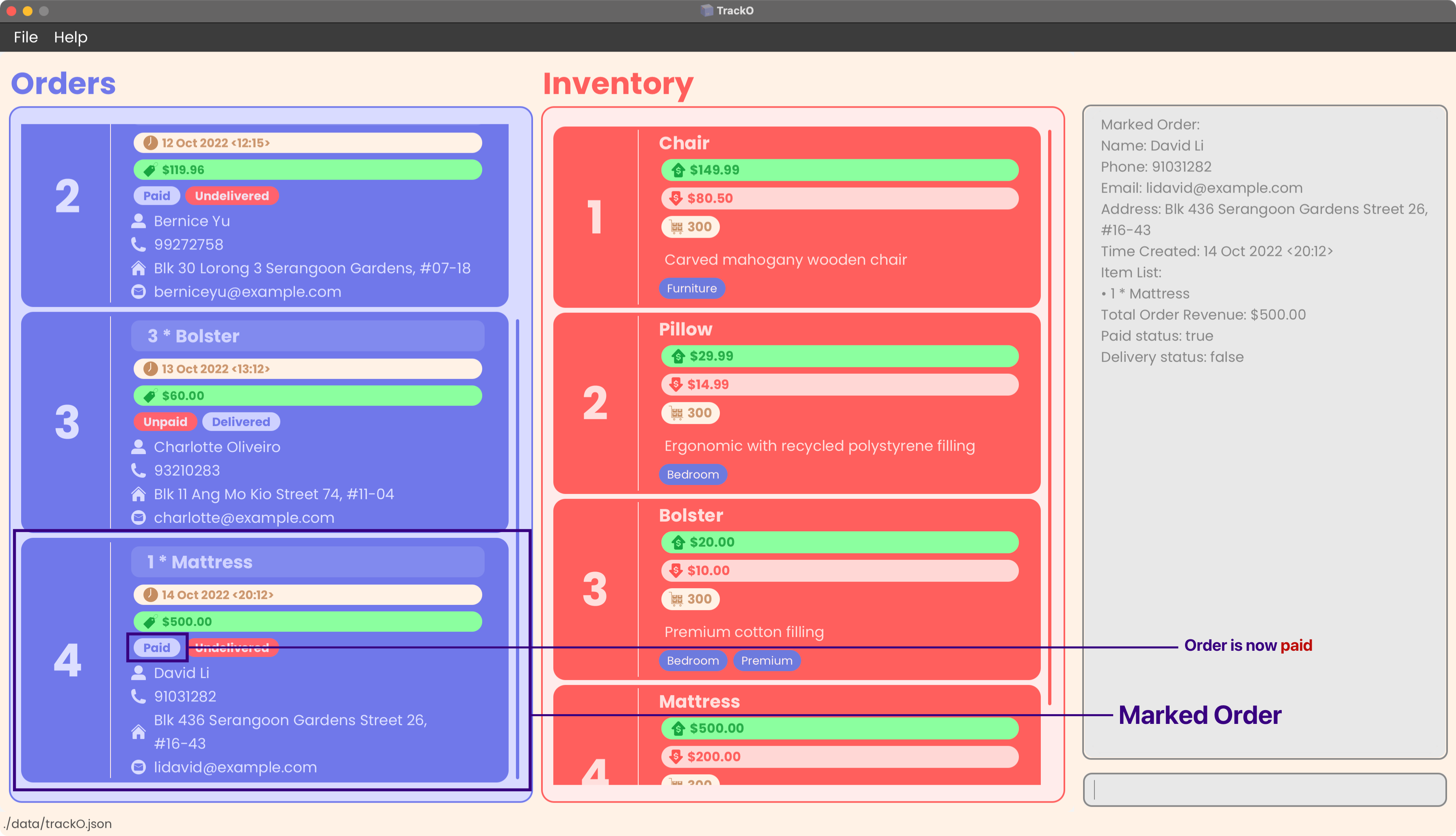
-
When you enter
marko 2 -don our sample data, TrackO will mark the order at index2in the currently displayed list asdelivered. However, because the order was previously marked aspaid, the label will showCompletedand the color of the order card is tinted gray.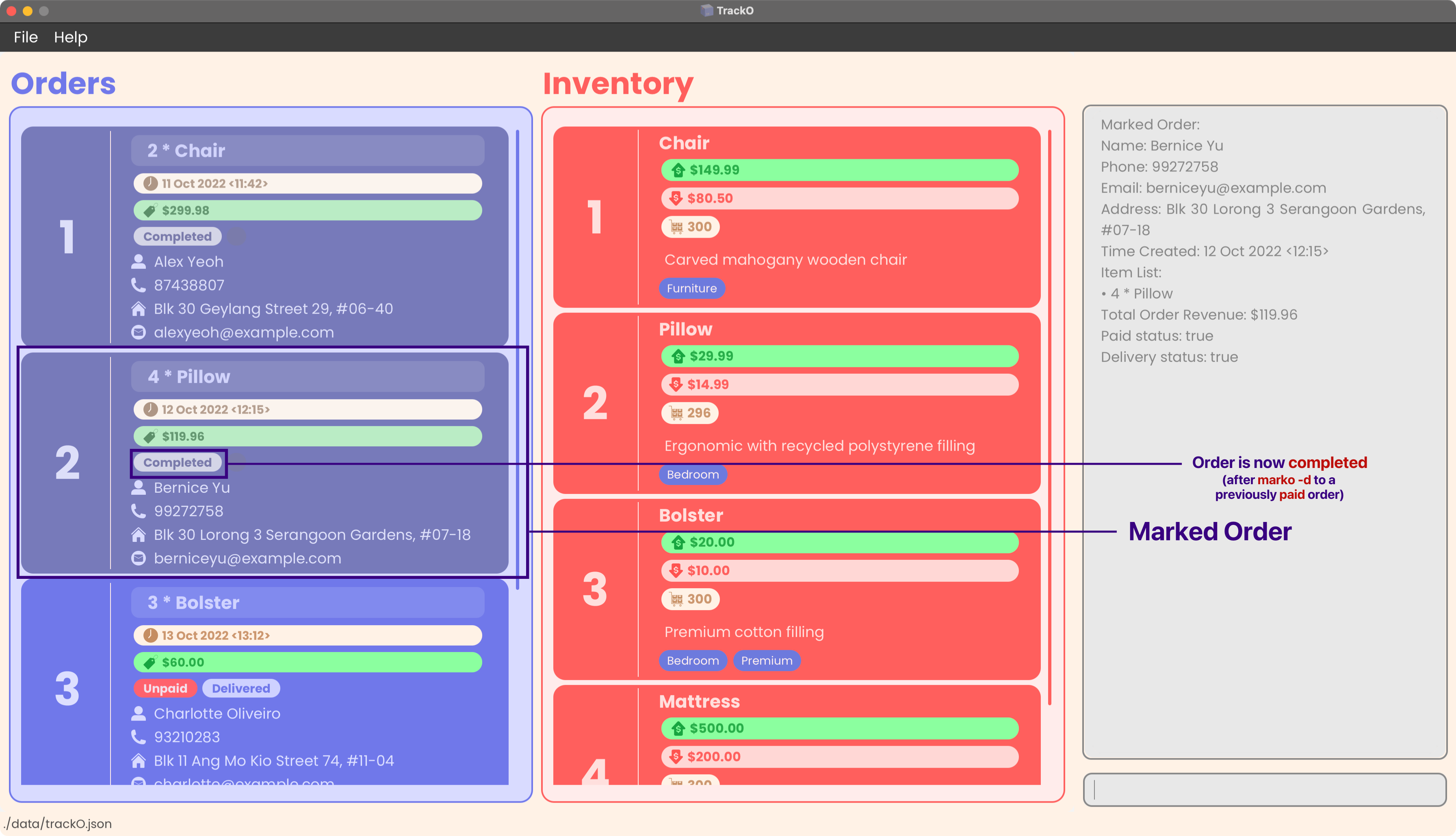
General features
The commands included here are TrackO’s general features for you to clear the sample data, access the help window, or to exit the application.
Getting help: help
Shows a window with a link to the user guide.

Clearing all data in TrackO: clear
If you want to clear all sample data present, clear is the command for you.
The command clear clears all data (in both Order List and Inventory List) from TrackO.
- Initiate the command to clear all data from TrackO.
Format:clear - Confirm the decision to clear all data.
Format:confirmorcancel-
clearwill trigger a message which prompts for user confirmation to clear the data in TrackO. - Keyword
confirm: confirms the deletion of all data in TrackO. All data in TrackO will be removed after this input. - Keyword
cancel: aborts the command to clear all data in TrackO. No changes to data in TrackO after this input. -
clearignores any input after. (e.g.clear chairwill have the same effect asclear)
-
confirm and done are case-sensitive. Thus, only the keywords in lower case are accepted.
An empty TrackO should look like this:

Exiting TrackO: exit
Exits the program.
Format: exit
Editing the data file
TrackO’s data is saved as a JSON file in [JAR file home folder]/data/trackO.json. Advanced users are welcome to
update data directly by editing that data file.
FAQ
Q: How do I transfer the data file to another computer?
A: Copy the home folder containing your TrackO.jar to the computer you are transferring to. The application should work as normal with all the existing data.
Q: How do I make sure that my computer is running Java 11?
A: Open the Terminal app built inside your computer (For Windows user, you can also use Powershell) and run the
following command: java --version. The version should then be displayed on the application.
If your screen is displaying java 11.x.x where x can be any number, then your computer is running Java 11.
If your computer is not running Java 11, you can install it here.
Please install according to the operating system that
you are using (any of the options is fine, as they are all Java 11).
Q: I am unable to delete my item, what is happening?
A: It is likely that the item you are trying to delete is linked to an order that is uncompleted, i.e. not paid or not delivered, or both. You need to mark the order as completed (refer to marko) if you want to delete the item.
Q: I am unable to edit my item’s item name and prices, what should I do?
A: Just like the previous question, it is likely that the item you are trying to delete is linked to an order that
is uncompleted. You are not allowed to edit the item’s name, cost price, and sell price before you complete te order.
This is the intended behavior of the application as of v1.4, to prevent orders that are already paid to display a
false revenue.
Command summary
| Action | Format, Examples |
|---|---|
| Add An Inventory Item |
addi n/NAME q/QUANTITY d/DESCRIPTION [t/TAG]… sp/SELL_PRICE cp/COST_PRICE e.g. addi n/Chair q/20 d/Swedish Wooden chair t/Furniture sp/79.99 cp/50.00 [t/TAG]…
|
| Delete An Inventory Item |
deletei INDEXe.g. deletei 3
|
| List All Inventory Items | listi |
| Find Inventory Item(s) |
findi KEYWORD [MORE_KEYWORDS] e.g. findi blue shirt
|
| Edit An Inventory Item |
editi INDEX [i/ITEM_NAME] [q/QUANTITY] [d/DESCRIPTION] [sp/SELL_PRICE] [cp/COST_PRICE] [t/TAG]…e.g. editi 2 i/Table q/200 d/Metal Table t/Fragile
|
| Add An Order |
addo n/NAME p/PHONE e/EMAIL a/ADDRESS e.g. addo n/John Doe p/91234567 e/johndoe@example.com a/48 Westwood Terrace then, i/ITEM_NAME q/QUANTITY as many times as required e.g. i/Pillow q/2 followed by done or cancel
|
| List All Orders | listo |
| Find Order(s) |
findo [-d OR -D] [-p OR -P] [i/ITEM_KEYWORD [MORE_ITEM_KEYWORDS]] [a/ADDRESS_KEYWORD [MORE_ADDRESS_KEYWORDS]] [n/NAME_KEYWORD [MORE_NAME_KEYWORDS]], where all flags are optional and only 1 prefix is compulsory e.g. findo -d i/keychain n/Alex
|
| Delete An Order |
deleteo INDEX e.g. deleteo 2
|
| Edit An Order |
edito INDEX [n/NAME] [p/PHONE] [e/EMAIL] [a/ADDRESS] [i/ITEM_NAME q/QUANTITY] e.g. edito 2 n/Peter p/98765432 e/peter@email.com a/123 Apartment Unit, #05-11
|
| Mark An Order |
marko INDEX [-p] [-d] e.g. marko 2 -d, marko 3 -p -d
|
| Sort Orders |
sorto new or sorto old
|
| Getting Help | help |
| Clear |
clearfollowed by confirm or cancel when prompted |
| Exit | exit |
Glossary
CLI
CLI stands for Command Line Interface. A CLI is a text-based user interface in which a program connects to the user.
Through a CLI, users interact with a system or application by typing in commands in the form of text. The system then executes
the typed in command in response.
Command
An instruction for the application to execute.
GUI
GUI stands for Graphical User Interface. A GUI is a user interface that provides interactive visual components (e.g. icons, etc.).
Through a GUI, users interact with a system or application by clicking on these elements. The system then responds to the user’s actions
by updating the user interface.
Index
Index refers to the position of an order or item in the list. When we say that an item is at Index 2, it means that
the item is currently in the second position on the list.
Inventory
Any item that the business needs to operate.
JAR file
JAR stands for Java Archive and is a file format that is used to store the files to run TrackO. JAR files are
executables, which means that you can run it by double-clicking the file.
Java
The programming language used to develop TrackO. Java 11 is also required to run TrackO on your device.
JSON file
JSON stands for JavaScript Object Notation, used for storing the user’s data in TrackO. JSON files are lightweight,
text-based, human-readable, and can be edited using a text editor.
Operating System
An operating system is the most important software in your computer that manages all your software and hardware. Linux,
macOS, and Windows may sound familiar to you; they are the operating systems in which TrackO can be run.
Order
Any sales promise that needs to be fulfilled.
Parameter
Parameters are the changeable inputs that you can give for a specific part of a command. For example, in the portion
i/NAME of the addi command, NAME can be replaced with the input that is meaningful to you (e.g, i/Cookie or
i/Keychain).